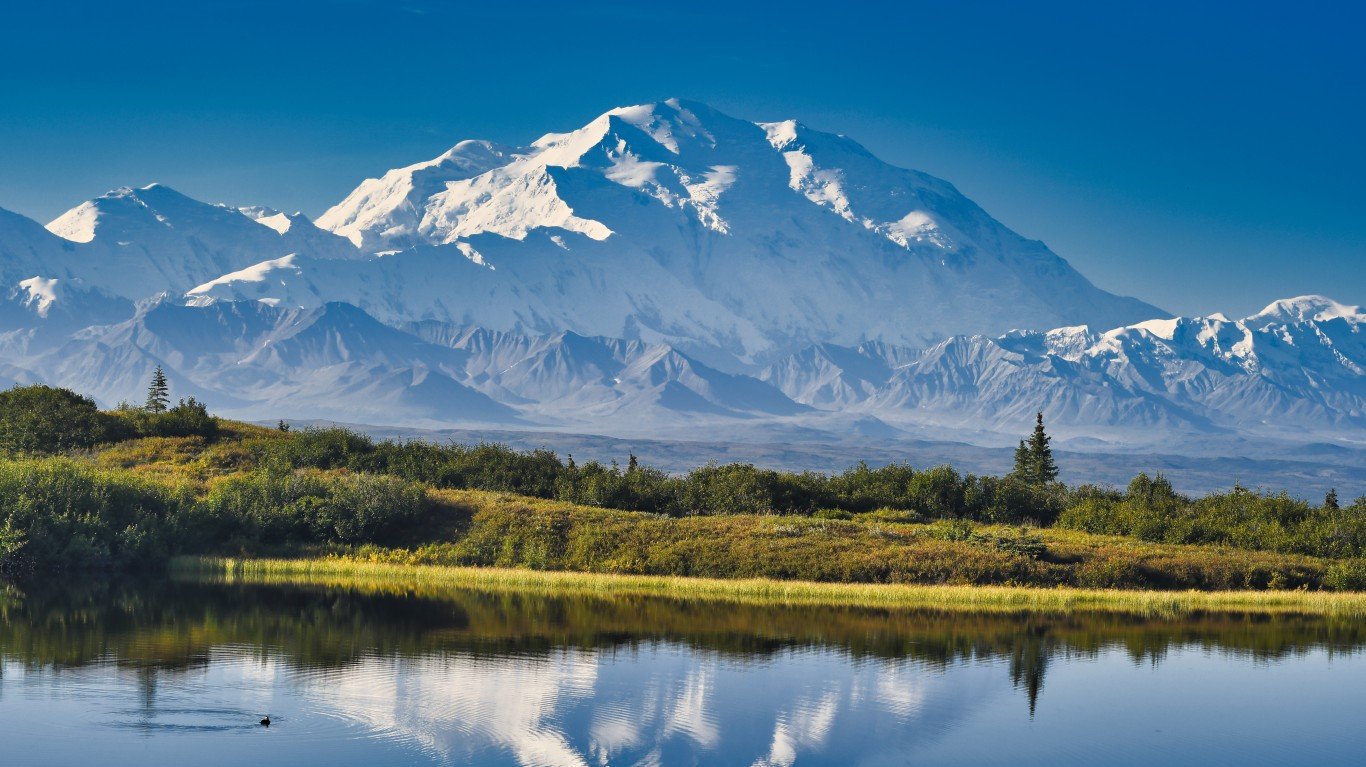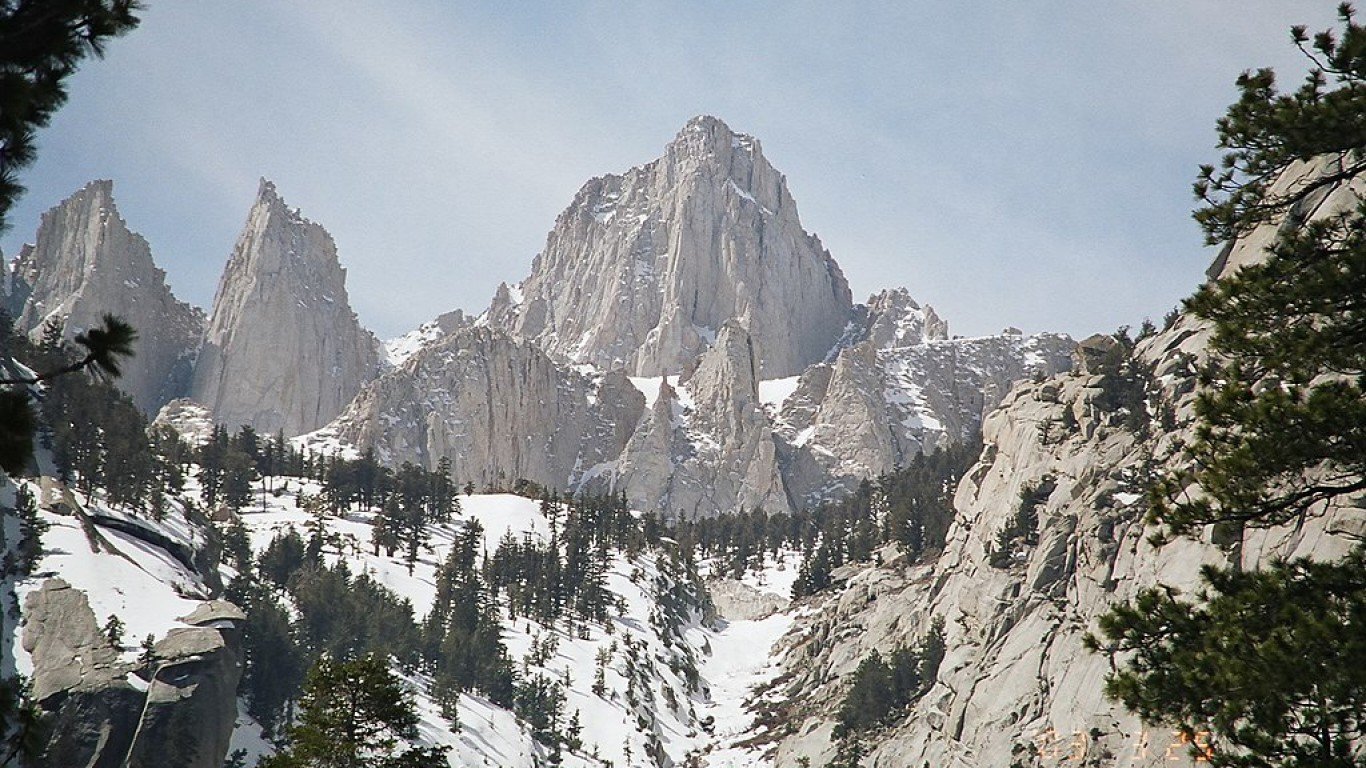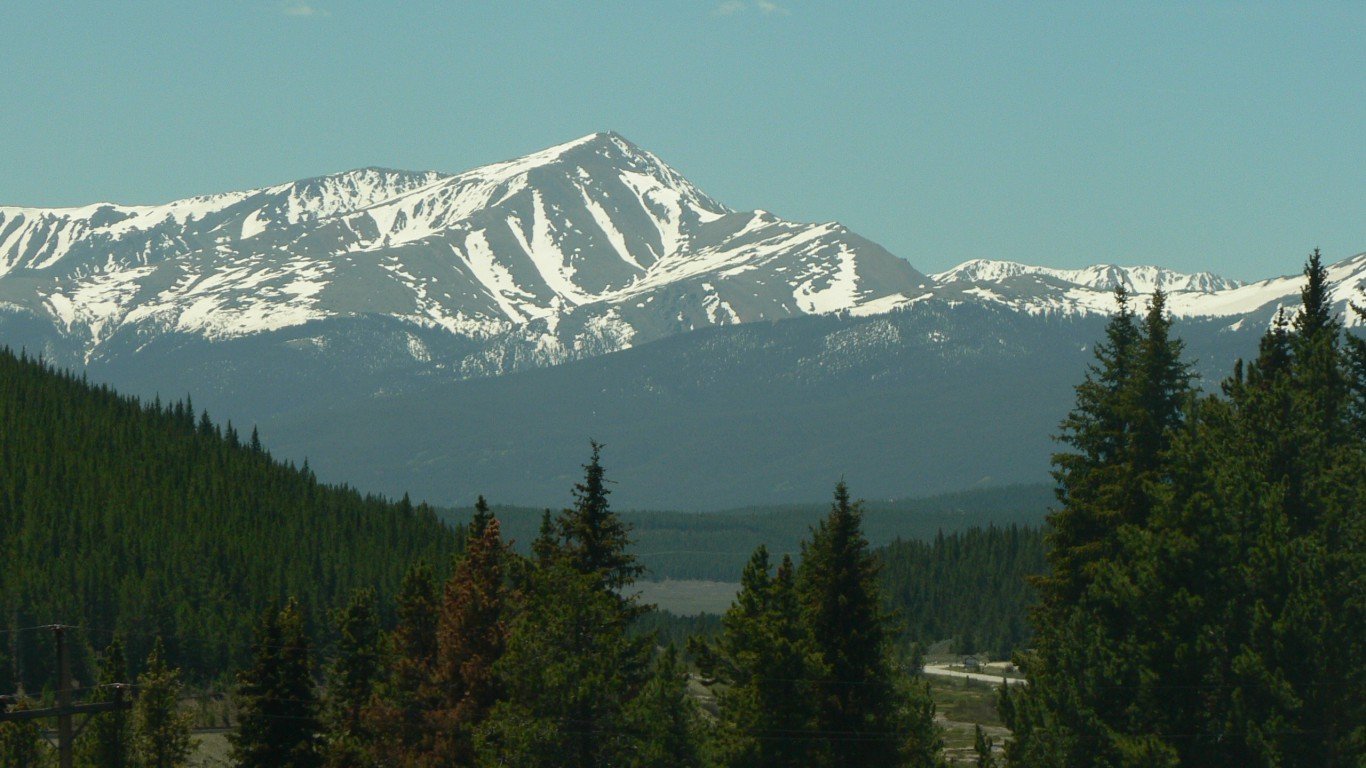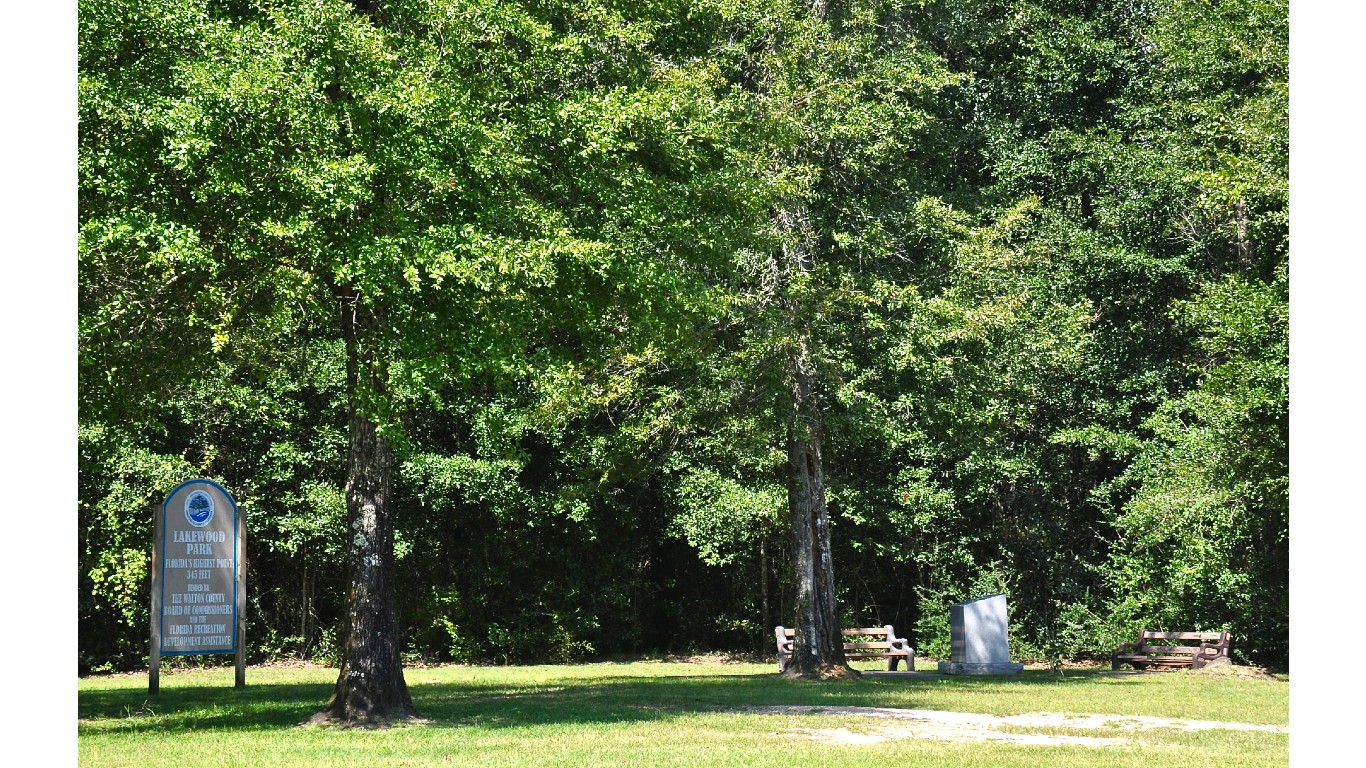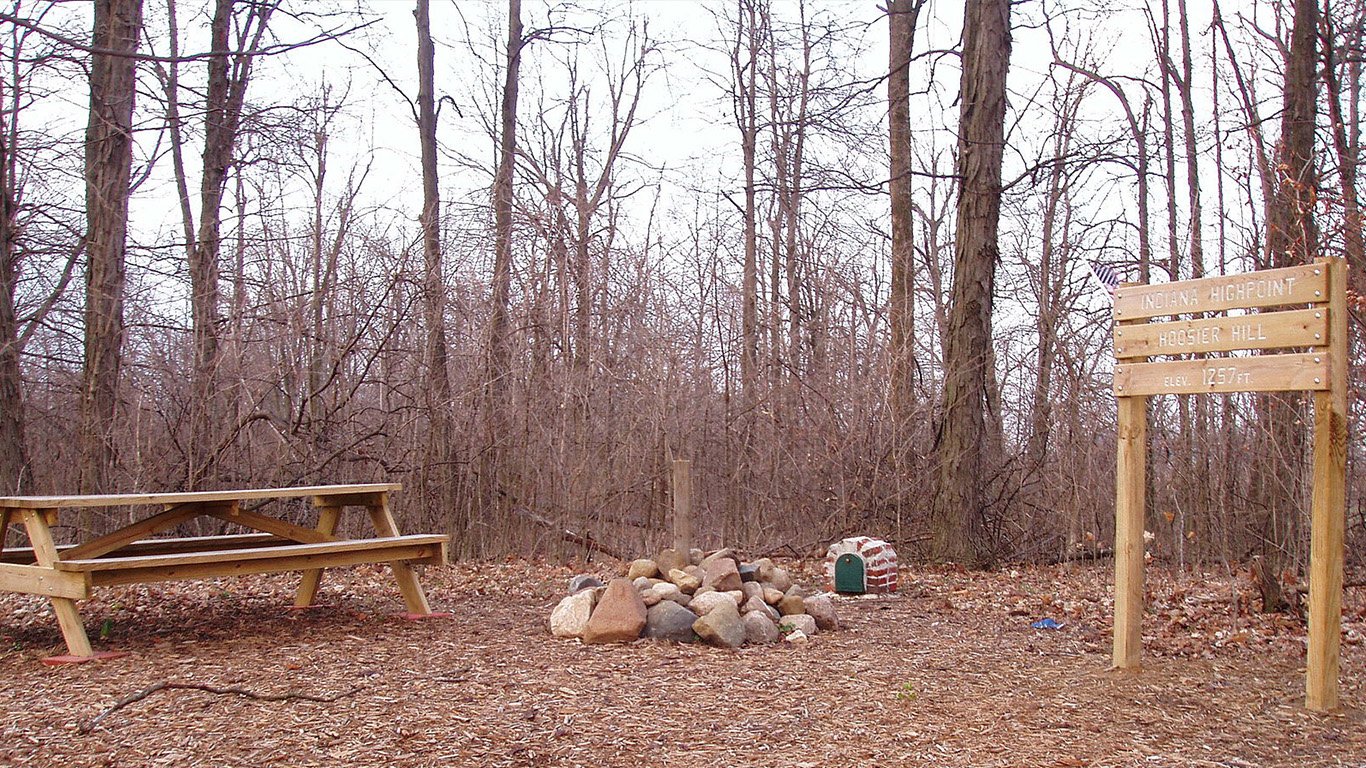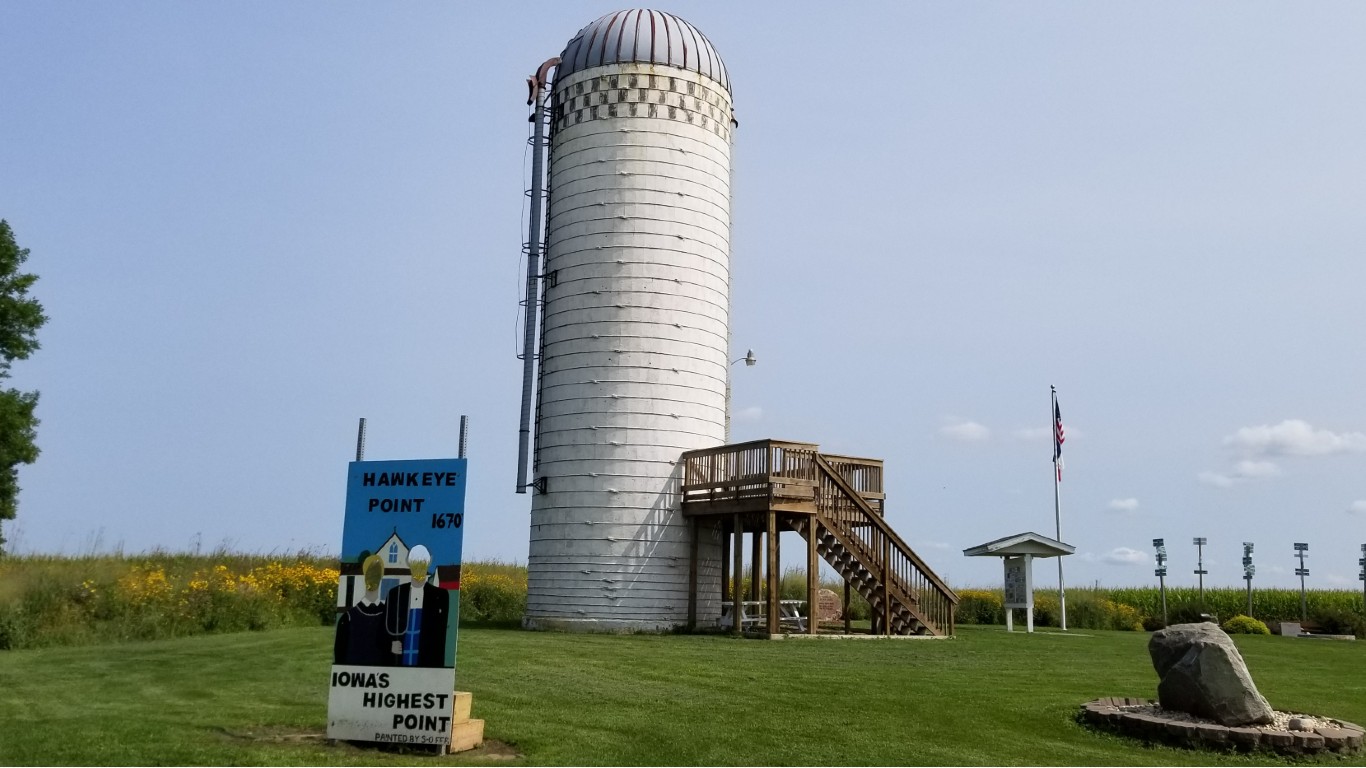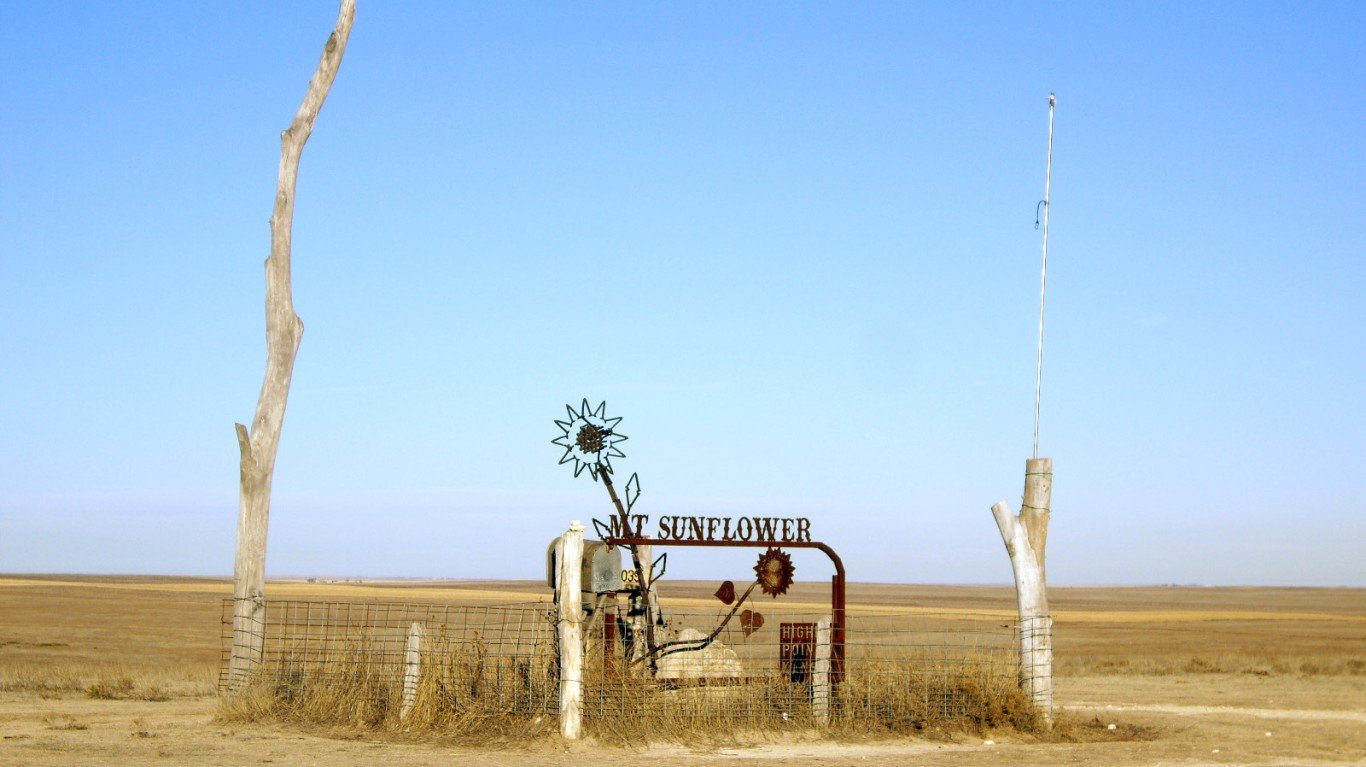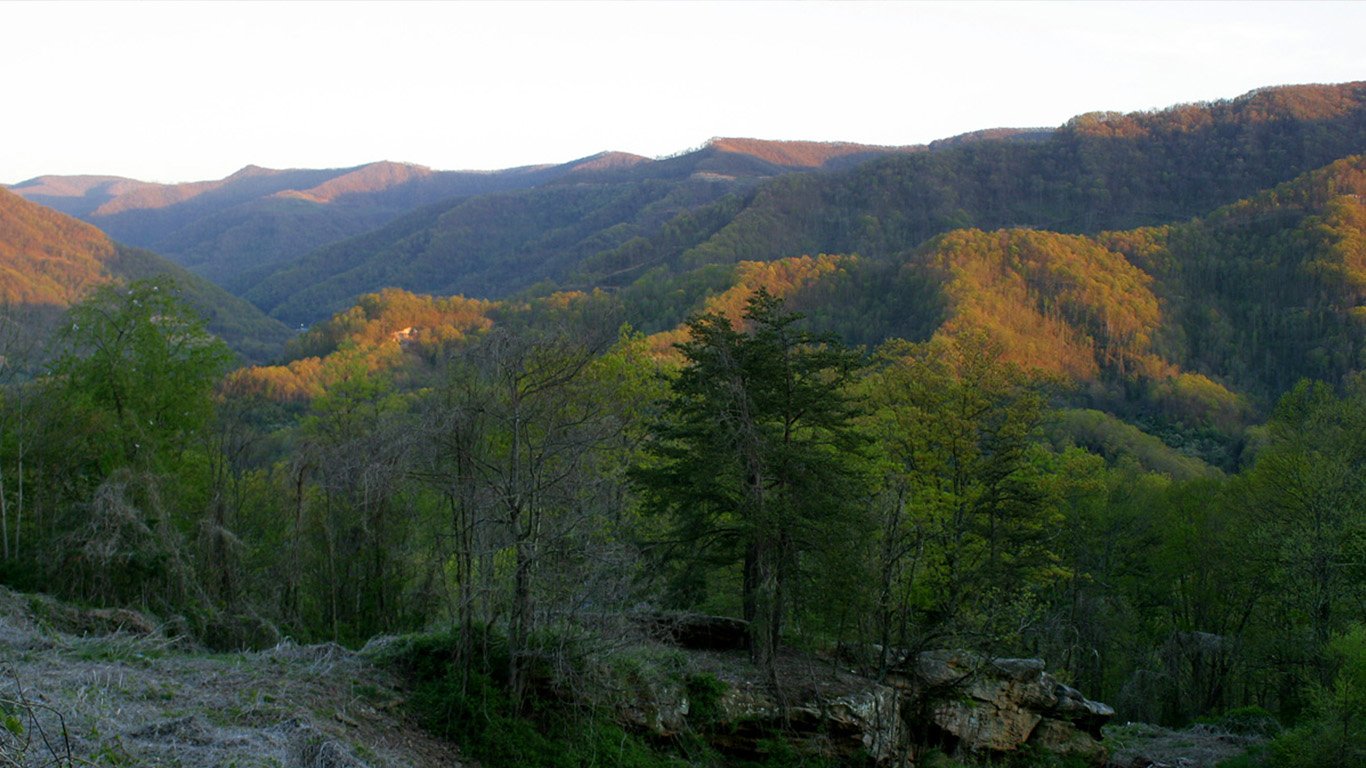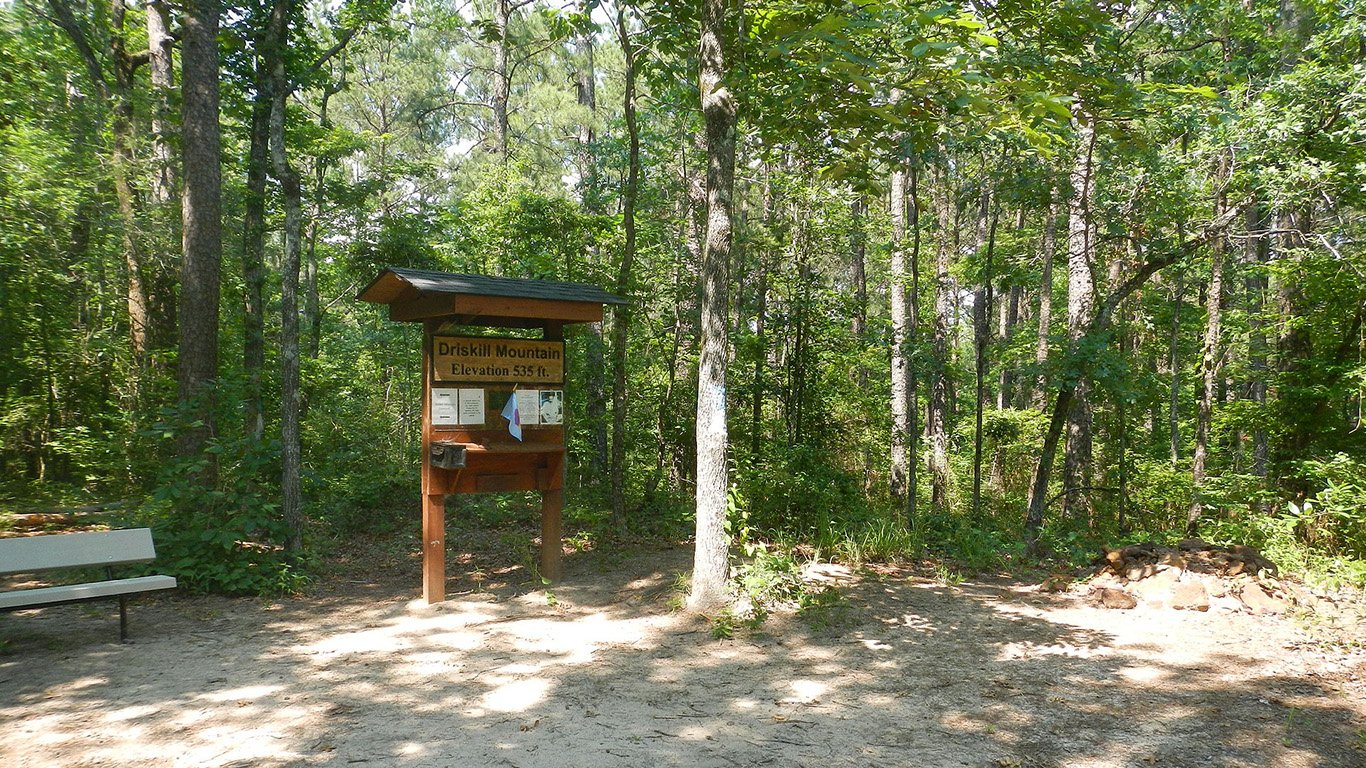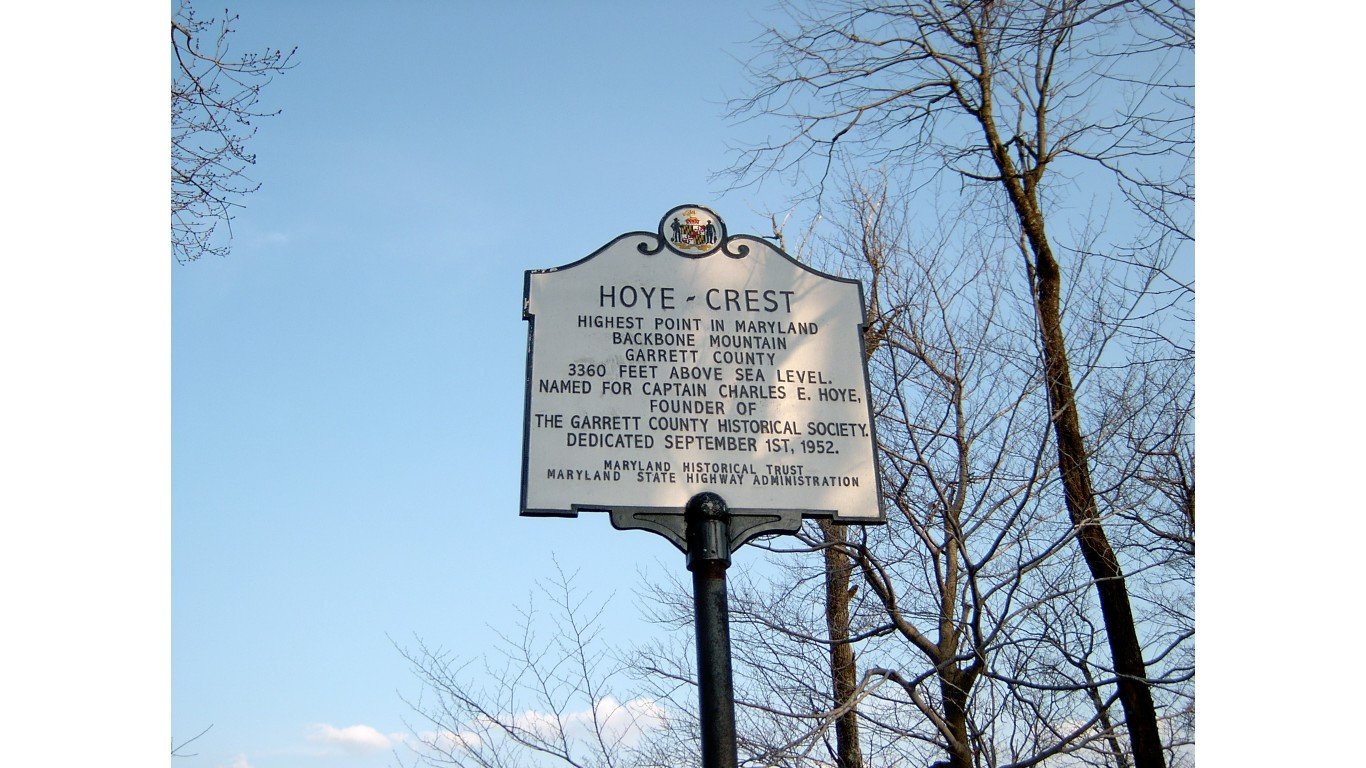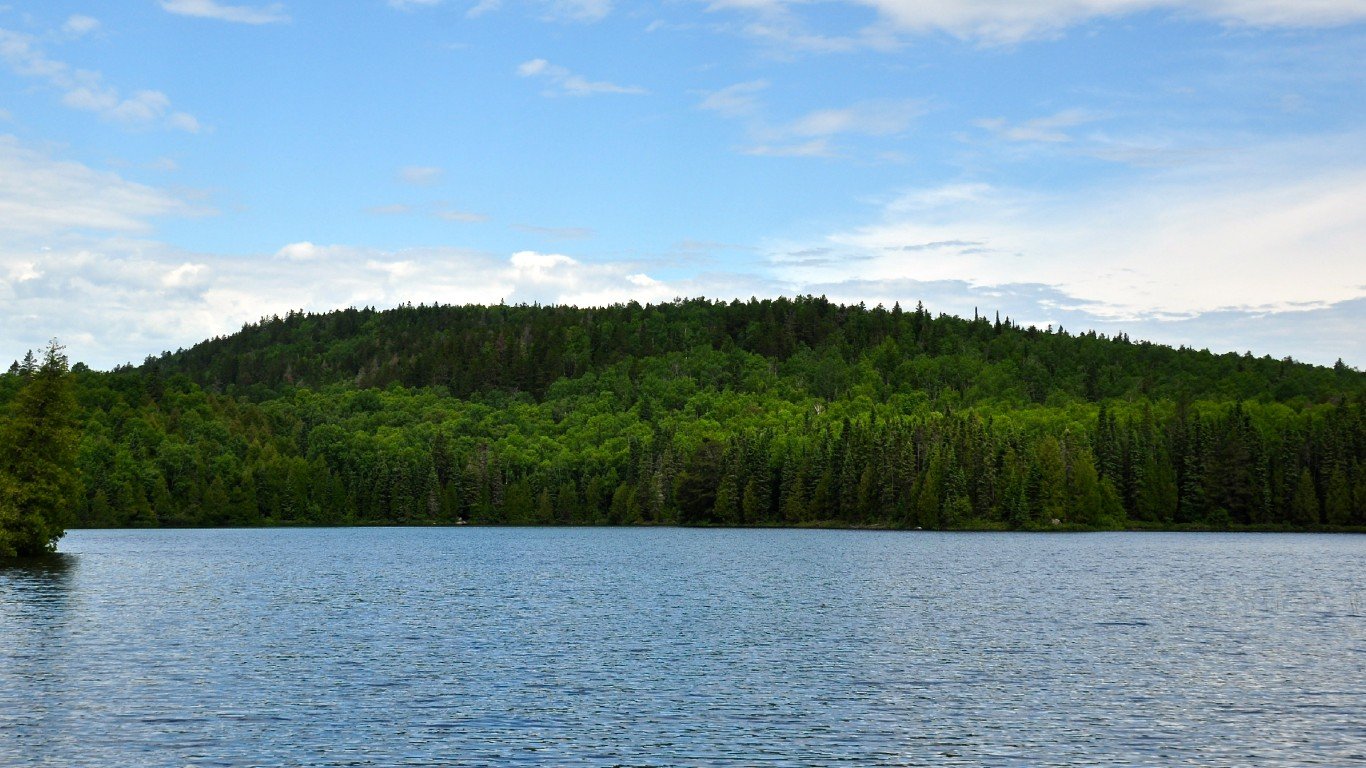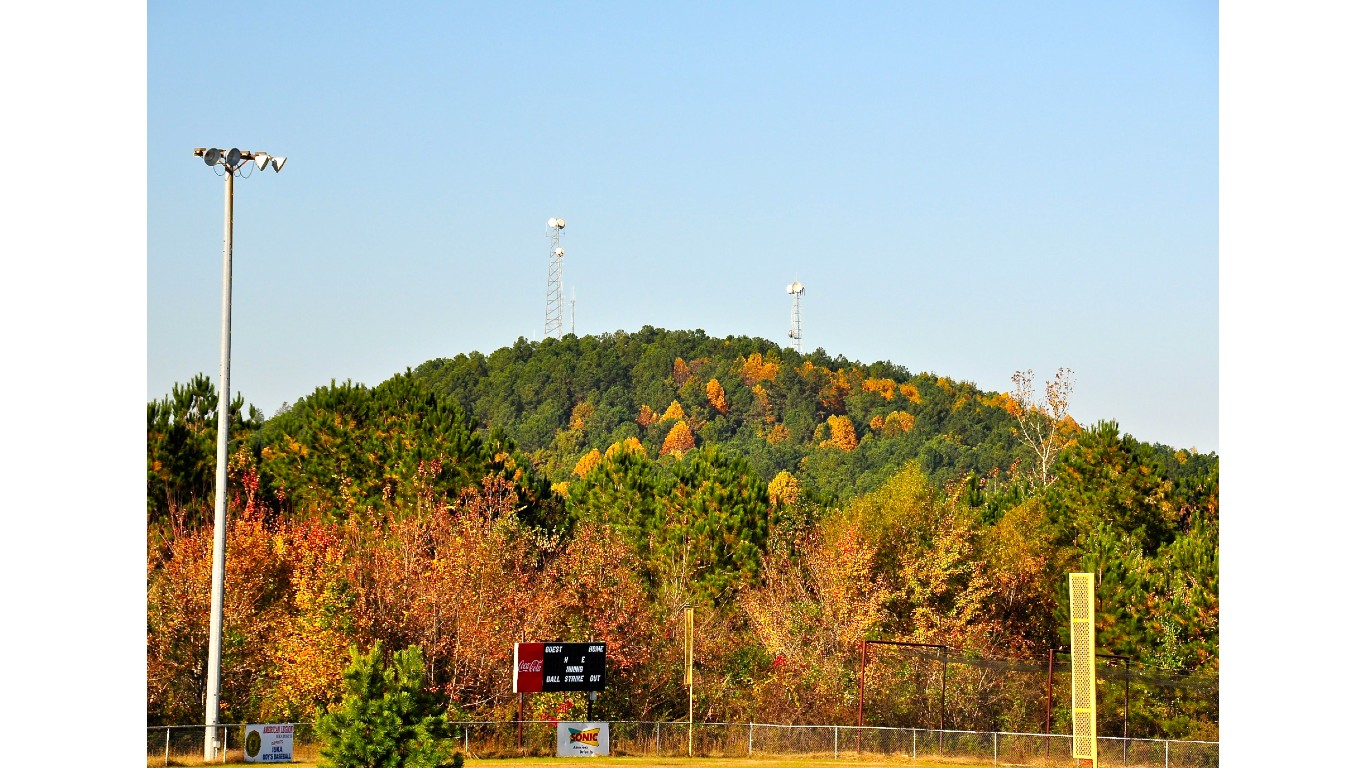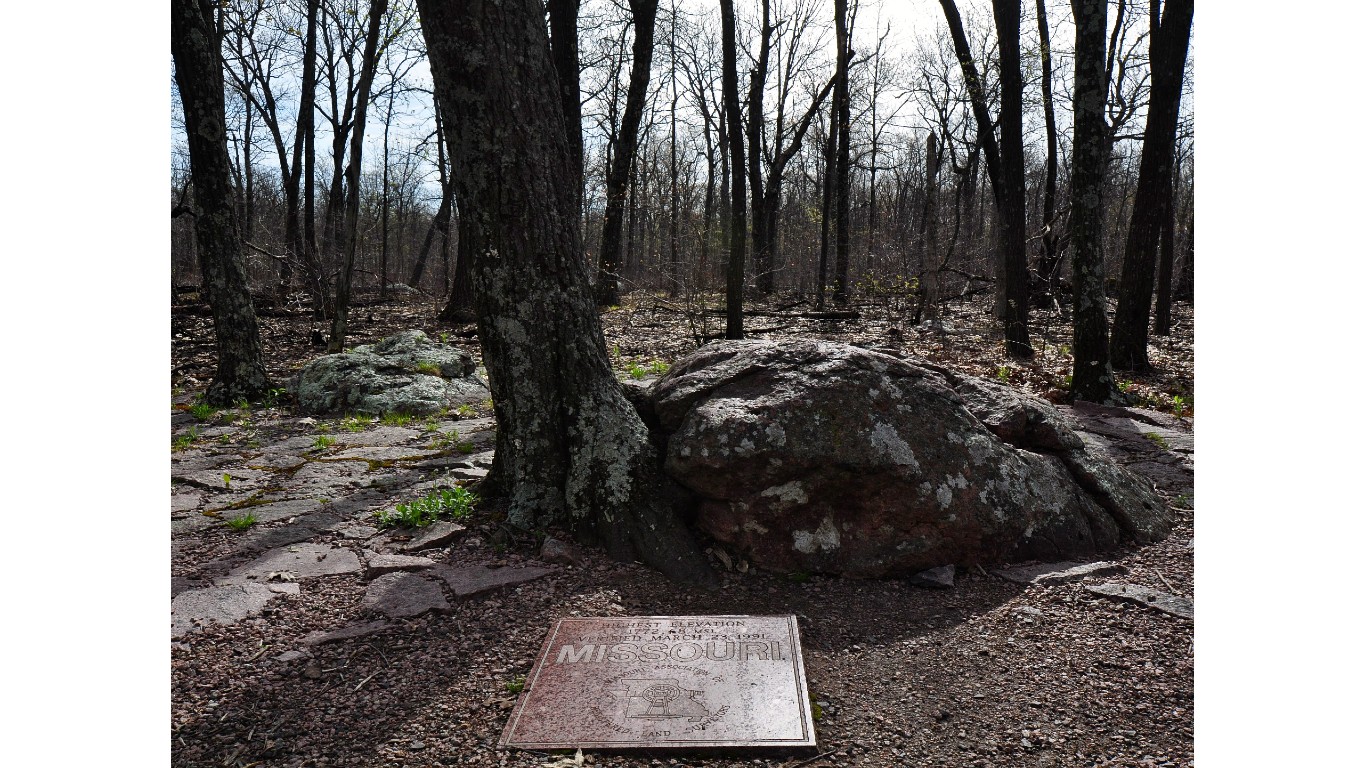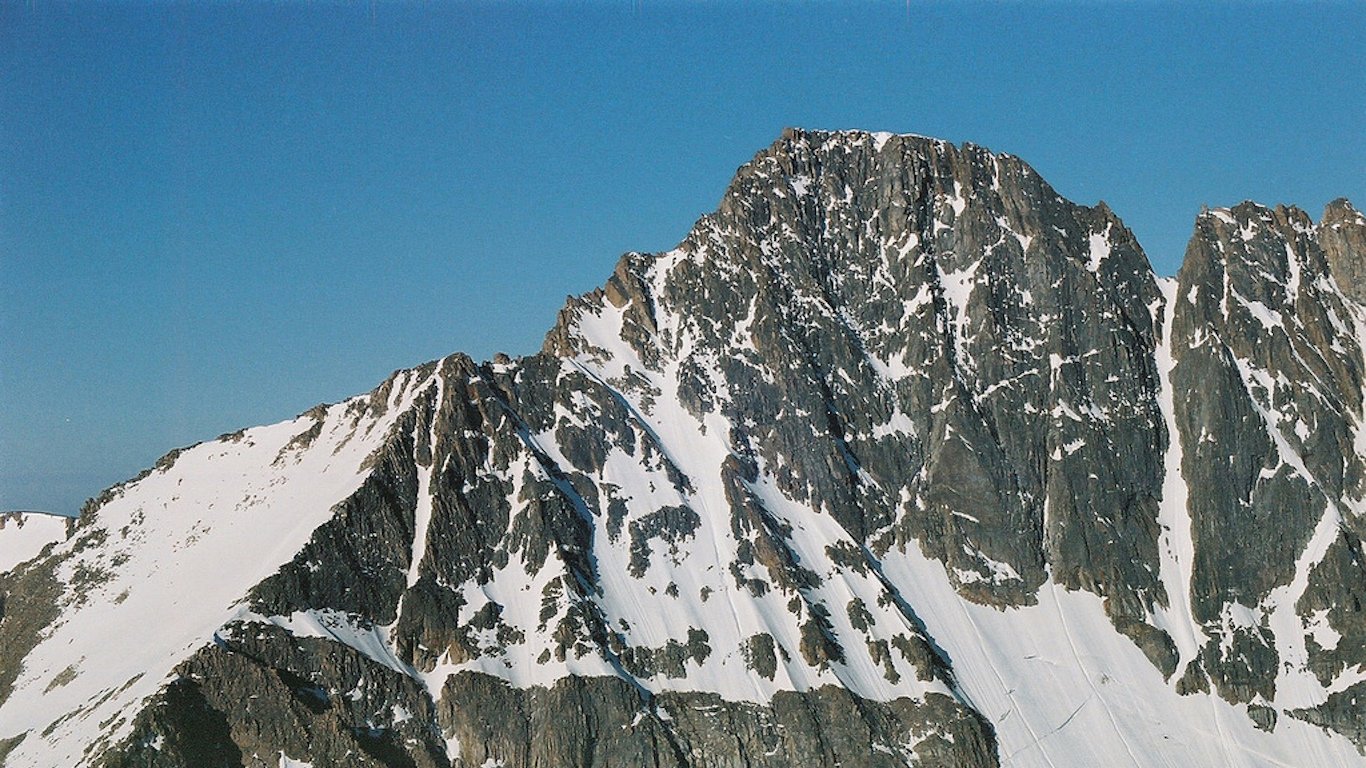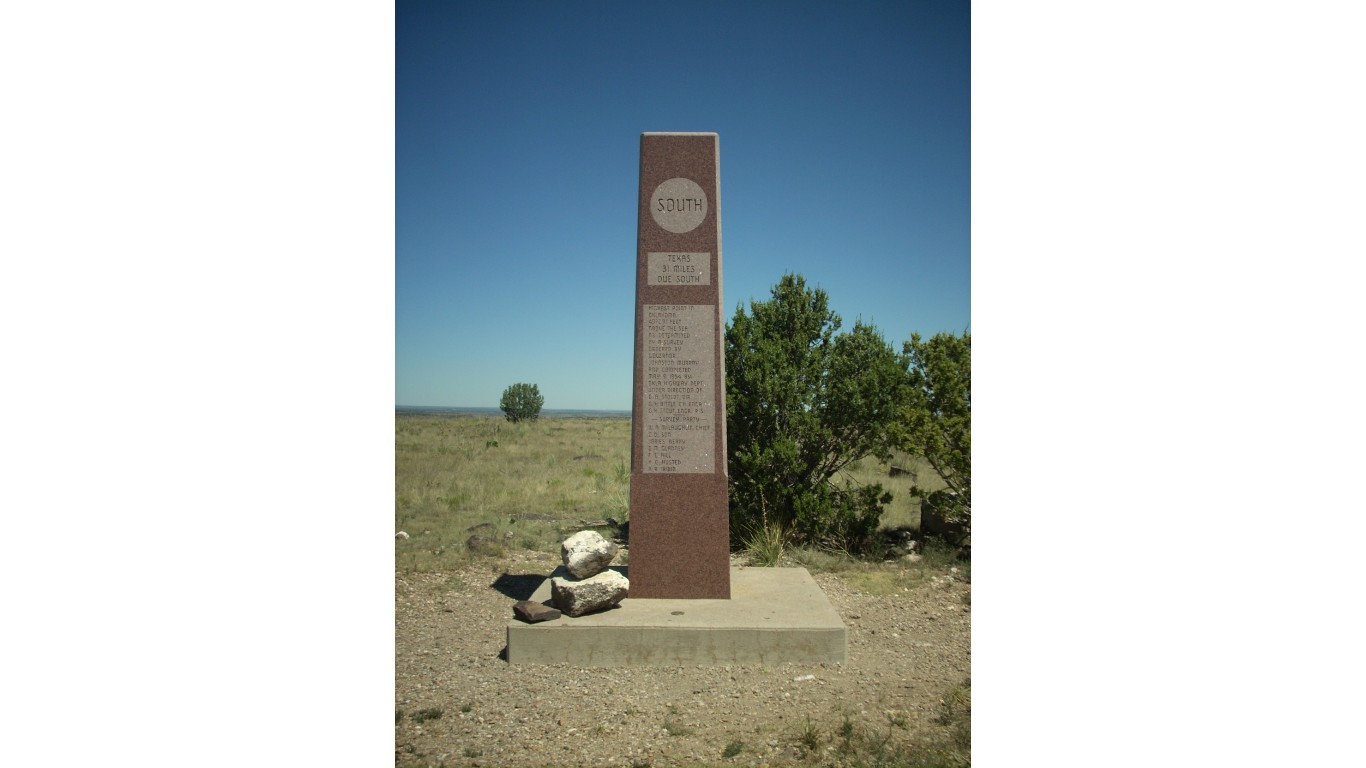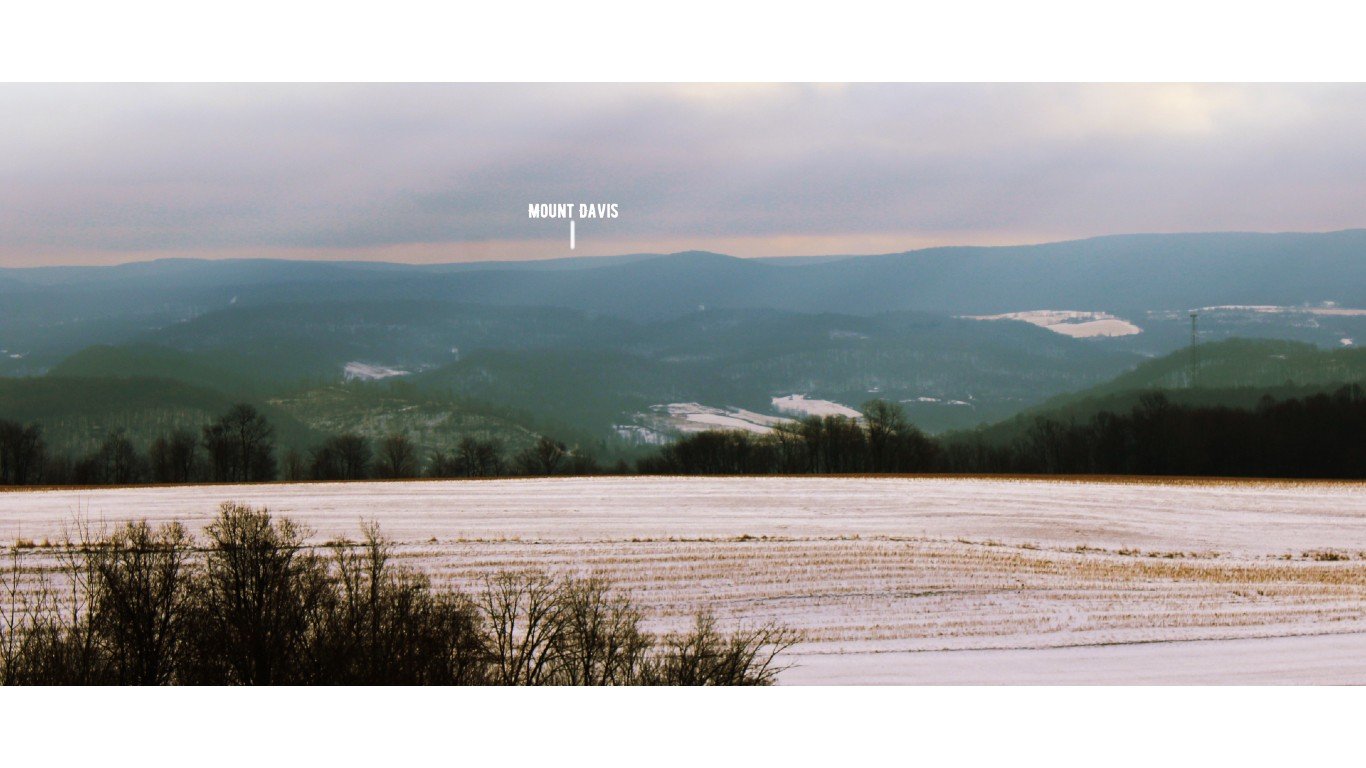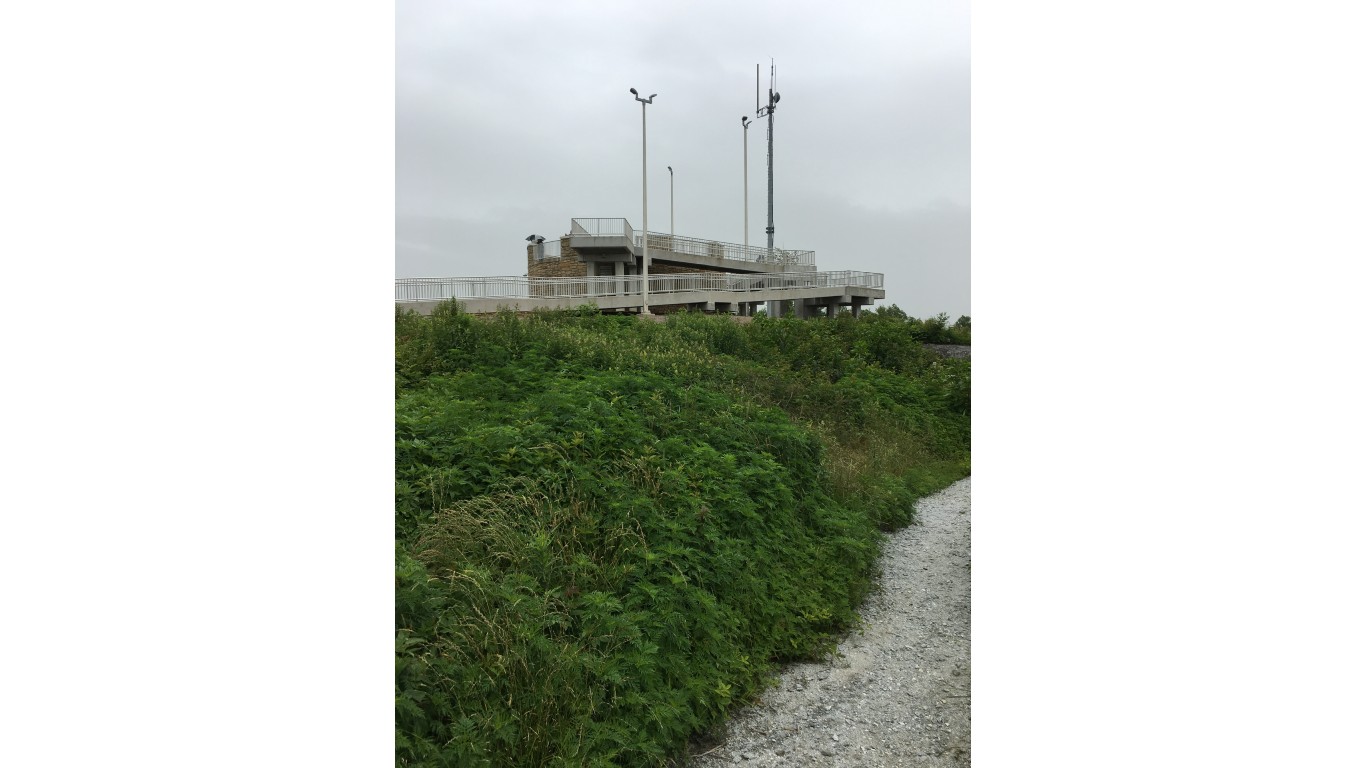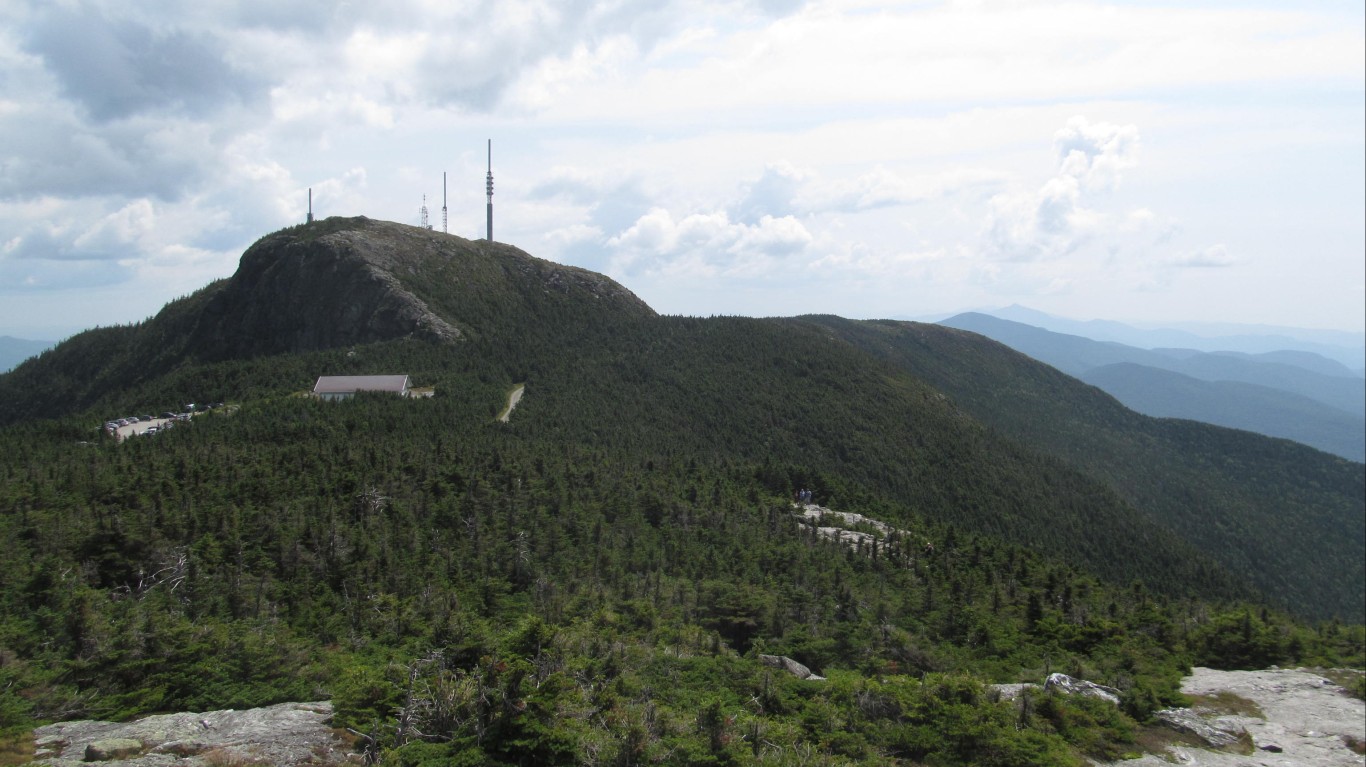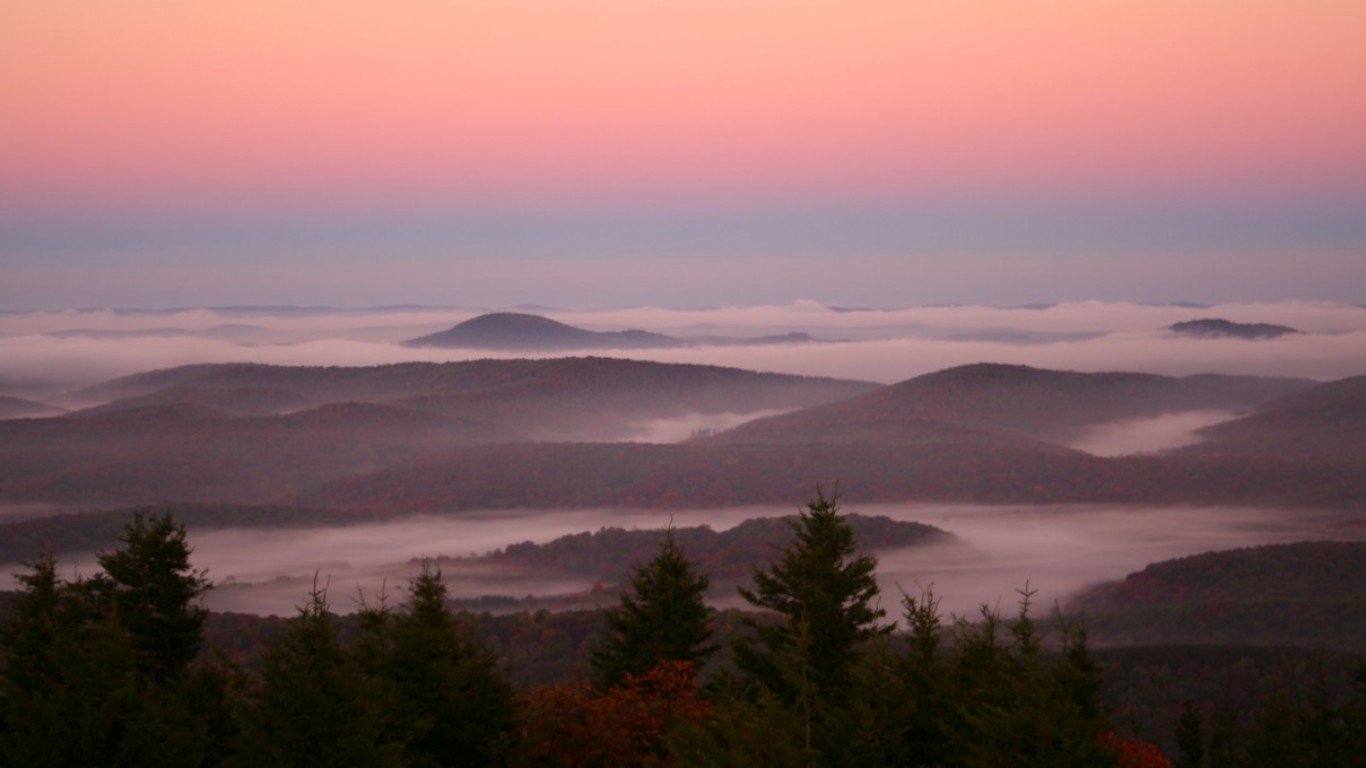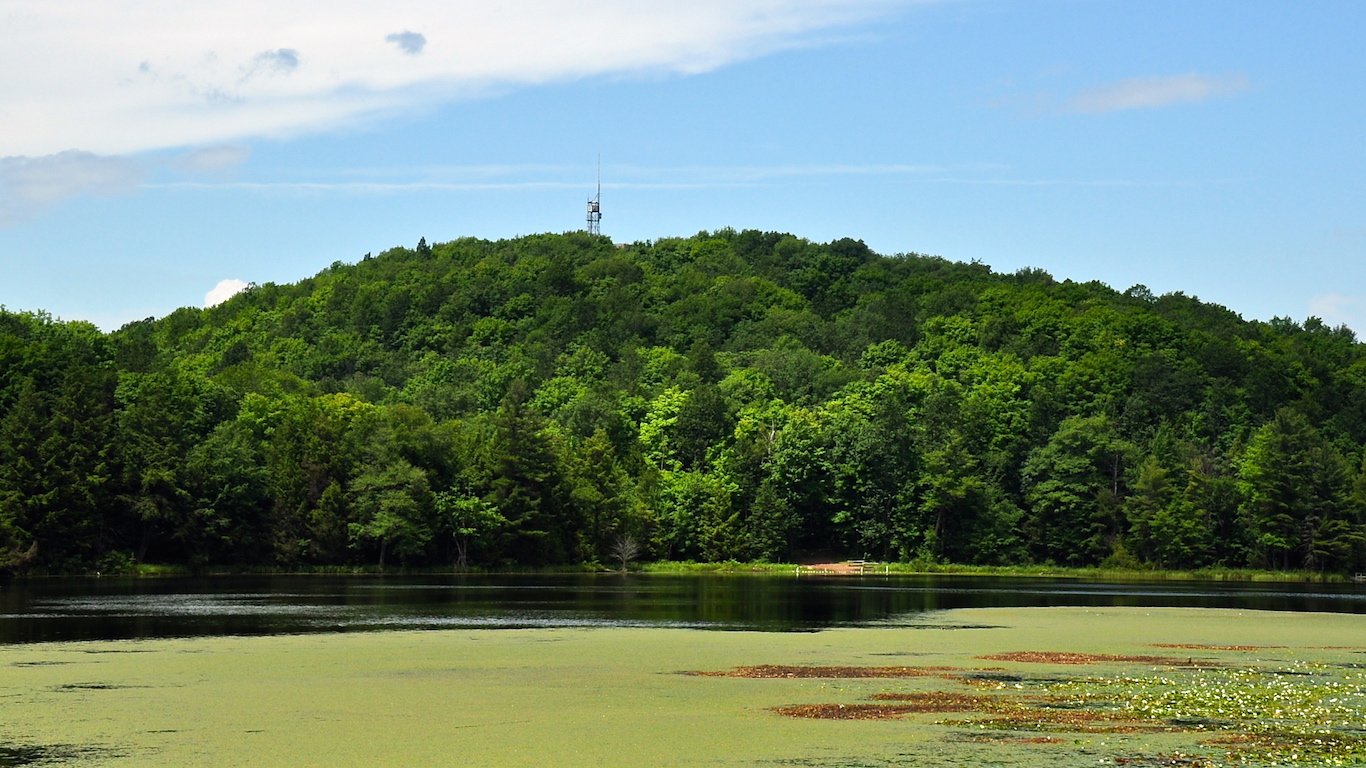The fourth-largest nation on earth, with 3.6 million square miles of land, The United States is one of the most geographically diverse countries on earth. America is home to the tallest land-based mountain when measured from base to summit: Mt. Denali in Alaska. It is also home to places similar to Death Valley, CA which at 282 ft. below sea level, is one of the lowest places on earth.
To determine the highest point in every state, 24/7 Tempo used data from the U.S. Census Bureau’s Statistical Abstract of the United States. The highest peaks range in elevation from just 345 feet in Florida to 20,320 feet in Alaska. Outdoor recreation consumer spending figures came from the Bureau of Economic Analysis and are for 2020. Conventional outdoor recreation activities (such as camping, hiking, boating, and hunting); other core activities.
In general, the tallest mountains are in the West. The nation’s 15 tallest peaks are all west of the 100th Meridian, or the 100° W longitude line that marks the eastern boundary of the Great Plains.
The states with the tallest mountains are not necessarily the highest states above sea level. While the summit of Washington’s Mount Rainier reaches 14,411 feet, the fourth highest peak of any state, the average elevation of the state is 1,700 feet, approximately 70% of the national average elevation of 2,500 feet. The state with the highest average elevation is Colorado, which stands at 6,800 feet above sea level. (These are the tallest mountains in the world.)
Some states also have more topographic diversity than others. While California has the second highest peak of any state, it also has the lowest elevation in the country. Situated 282 feet below sea level, Death Valley is the lowest point in both California and the United States. The difference between California’s 14,494-foot peak atop Mount Whitney and its Death Valley trough is nearly 3 miles. Meanwhile, in flatter states such as Florida and Delaware, the difference between the highest and lowest point is less than 500 feet.

1. Alabama
> Highest peak: Cheaha Mountain
> Elevation above sea level: 2,407 ft.
> Coordinates: 33.5° N, 85.8° W
> Value added from outdoor recreational activities: $4.23 billion
> Population: 4,903,185
The name “Cheaha” comes from the Muskogee word “chaha,” which translates to “high place.”
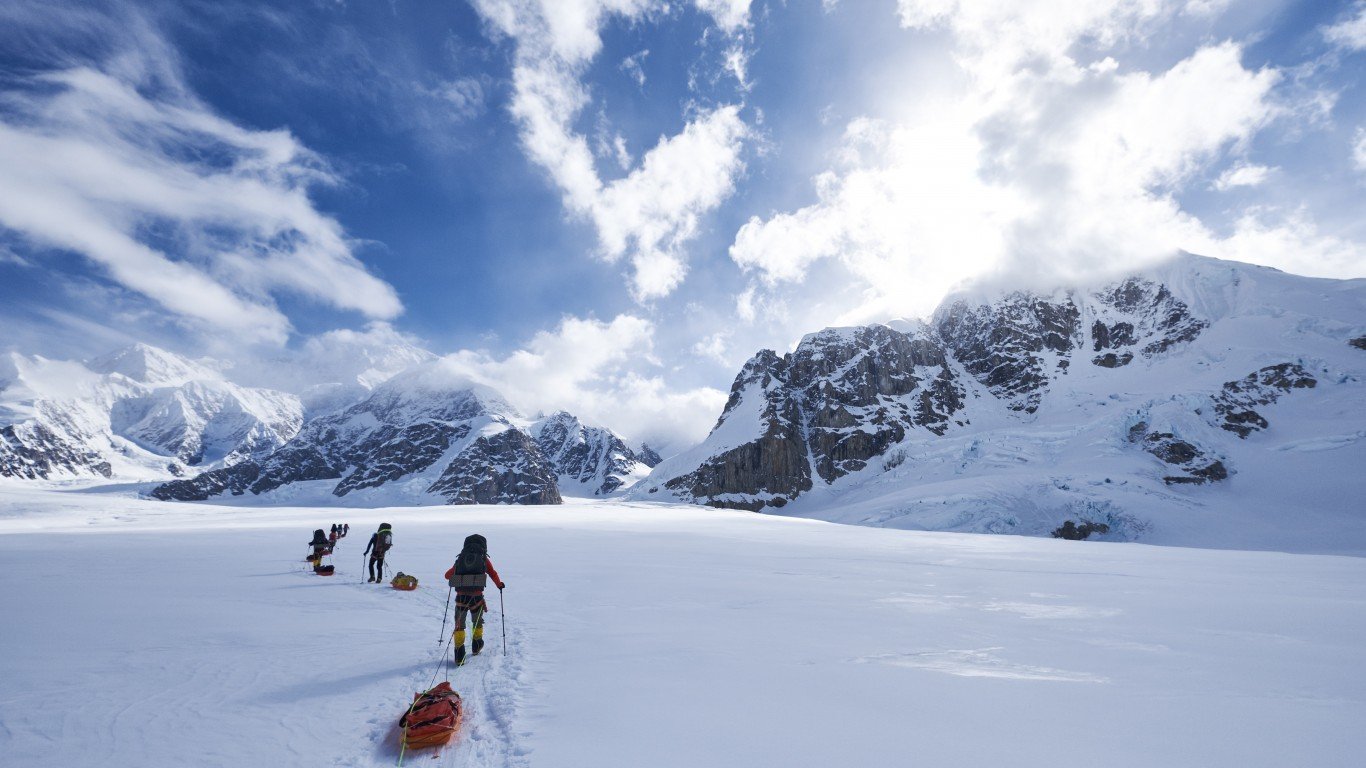
2. Alaska
> Highest peak: Denali
> Elevation above sea level: 20,320 ft.
> Coordinates: 63.1° N, 151.0° W
> Value added from outdoor recreational activities: $1.57 billion
> Population: 731,545
For over a century, Denali was known as Mount McKinley, but the moniker was returned to the original Native Alaskan name in 2015.

3. Arizona
> Highest peak: Humphreys Peak
> Elevation above sea level: 12,633 ft.
> Coordinates: 35.3° N, 111.7° W
> Value added from outdoor recreational activities: $7.65 billion
> Population: 7,278,717
Though it was named Humphreys Peak around 1870, the mountain was also named San Francisco Peak due to a General Land Office error. It wasn’t fixed until 1933.
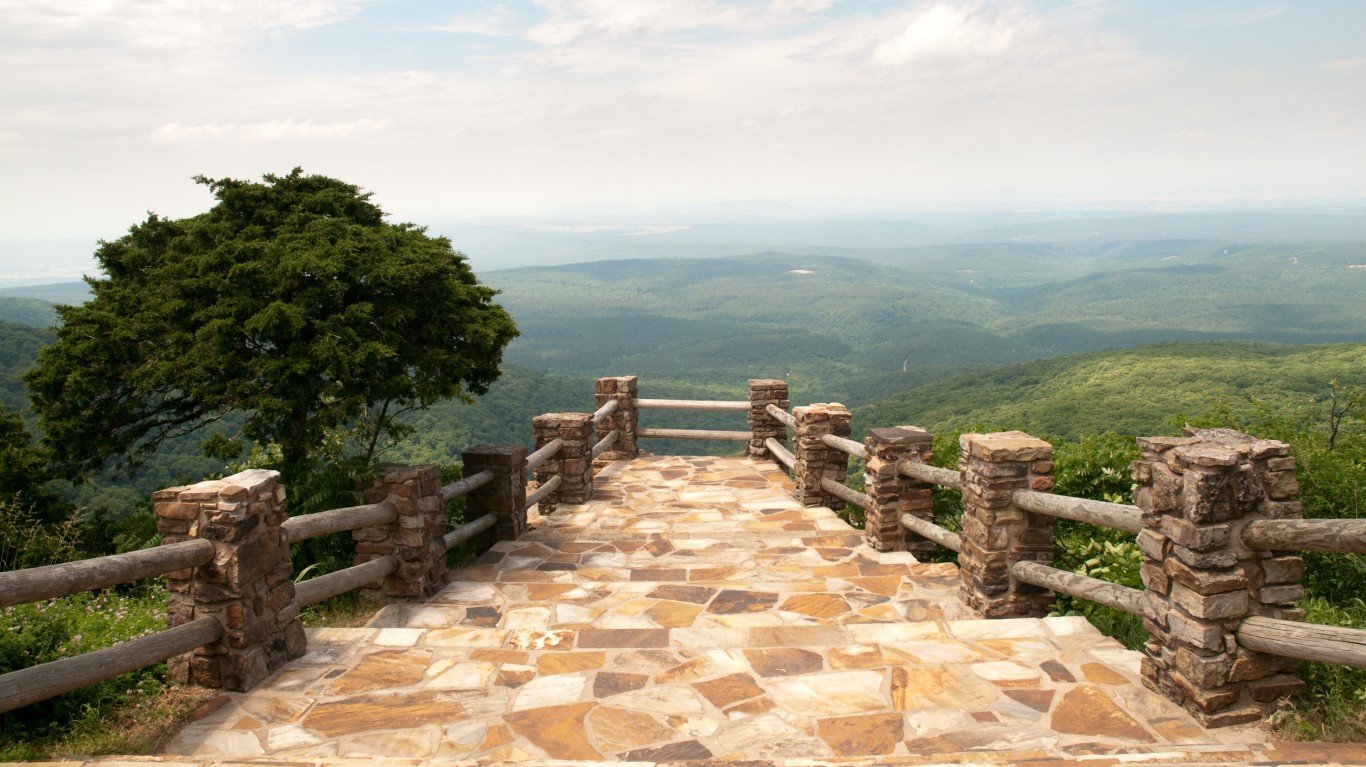
4. Arkansas
> Highest peak: Magazine Mountain
> Elevation above sea level: 2,753 ft.
> Coordinates: 35.2° N, 93.6° W
> Value added from outdoor recreational activities: $2.91 billion
> Population: 3,017,804
Mount Magazine got its peculiar name when French explorers heard a landslide and mistook the loud sound for an exploding ammunition magazine.
5. California
> Highest peak: Mount Whitney
> Elevation above sea level: 14,494 ft.
> Coordinates: 36.6° N, 118.3° W
> Value added from outdoor recreational activities: $44.5 billion
> Population: 39,512,223
The tallest mountain in the lower 48 states, Mount Whitney is such a popular climbing destination that hikers need a permit to climb it to minimize the ecological impact.
6. Colorado
> Highest peak: Mount Elbert
> Elevation above sea level: 14,433 ft.
> Coordinates: 39.1° N, 106.4° W
> Value added from outdoor recreational activities: $9.56 billion
> Population: 5,758,736
Even though Mount Elbert is the tallest peak in Colorado at 14,433 feet, it is one of the easier “14ers” to climb. Many hikers call it the “gentle giant” of the Rocky Mountains.

7. Connecticut
> Highest peak: Mount Frissell
> Elevation above sea level: 2,380 ft.
> Coordinates: 42.0° N, 73.5° W
> Value added from outdoor recreational activities: $3.30 billion
> Population: 3,565,287
Though part of Mount Frissell is the highest point in Connecticut, the peak is actually in Massachusetts. This makes Connecticut the only state whose highest point isn’t a true peak.
8. Delaware
> Highest peak: Ebright Road
> Elevation above sea level: 448 ft.
> Coordinates: 39.8° N, 75.5° W
> Value added from outdoor recreational activities: $1.14 billion
> Population: 973,764
Delaware has no mountains or peaks so its highest point, the Ebright Azimuth, is marked by a sign on a road in Centerville near the Pennsylvania border.
9. Florida
> Highest peak: Britton Hill
> Elevation above sea level: 345 ft.
> Coordinates: 31.0° N, 86.3° W
> Value added from outdoor recreational activities: $33.18 billion
> Population: 21,477,737
At just 345 feet, Britton Hill is the lowest high point of any state. Florida’s tourism website says the surrounding park is a great place for a family picnic and “your grandmother can get to the top without breaking a sweat.”
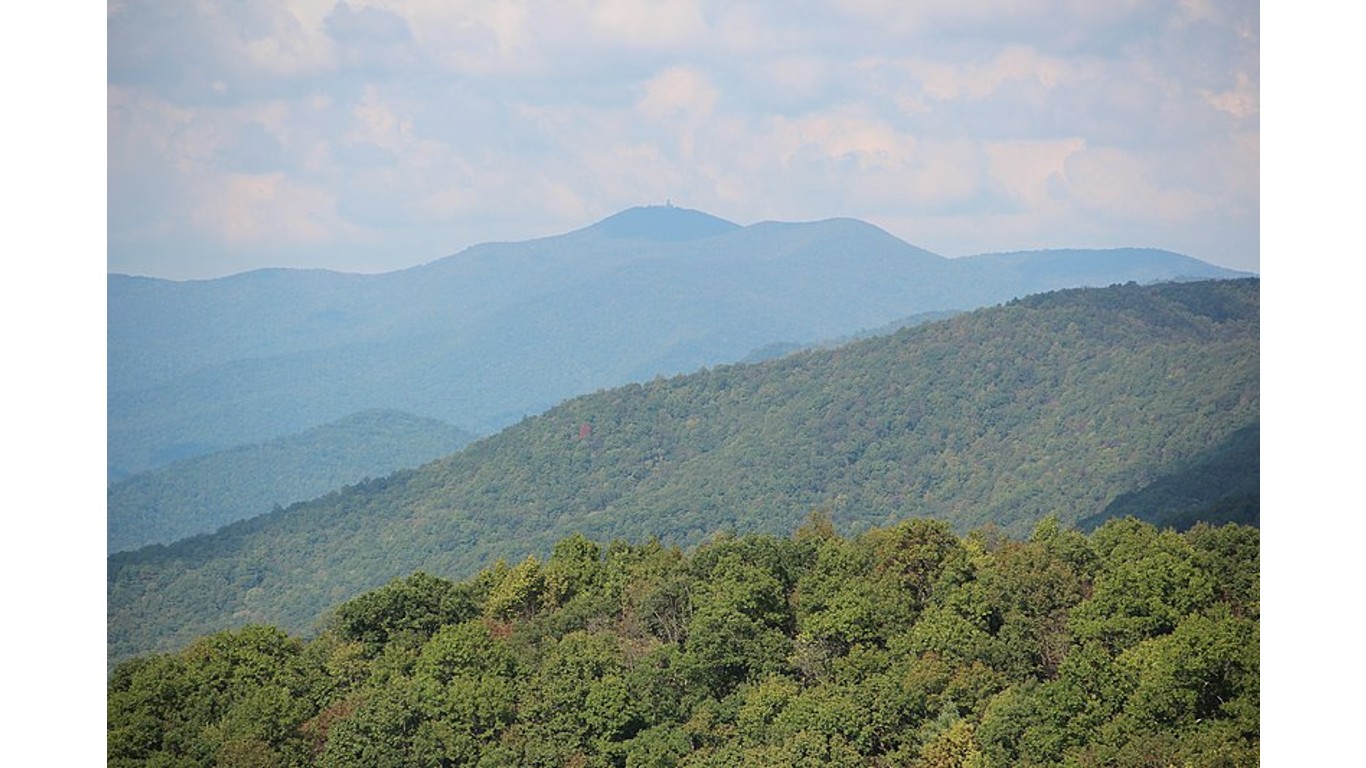
10. Georgia
> Highest peak: Brasstown Bald
> Elevation above sea level: 4,784 ft.
> Coordinates: 34.9° N, 83.8° W
> Value added from outdoor recreational activities: $10.80 billion
> Population: 10,617,423
If you climb Brasstown Bald, located in the northeastern corner of Georgia, you can reportedly see North Carolina, South Carolina, and Tennessee on a clear day.
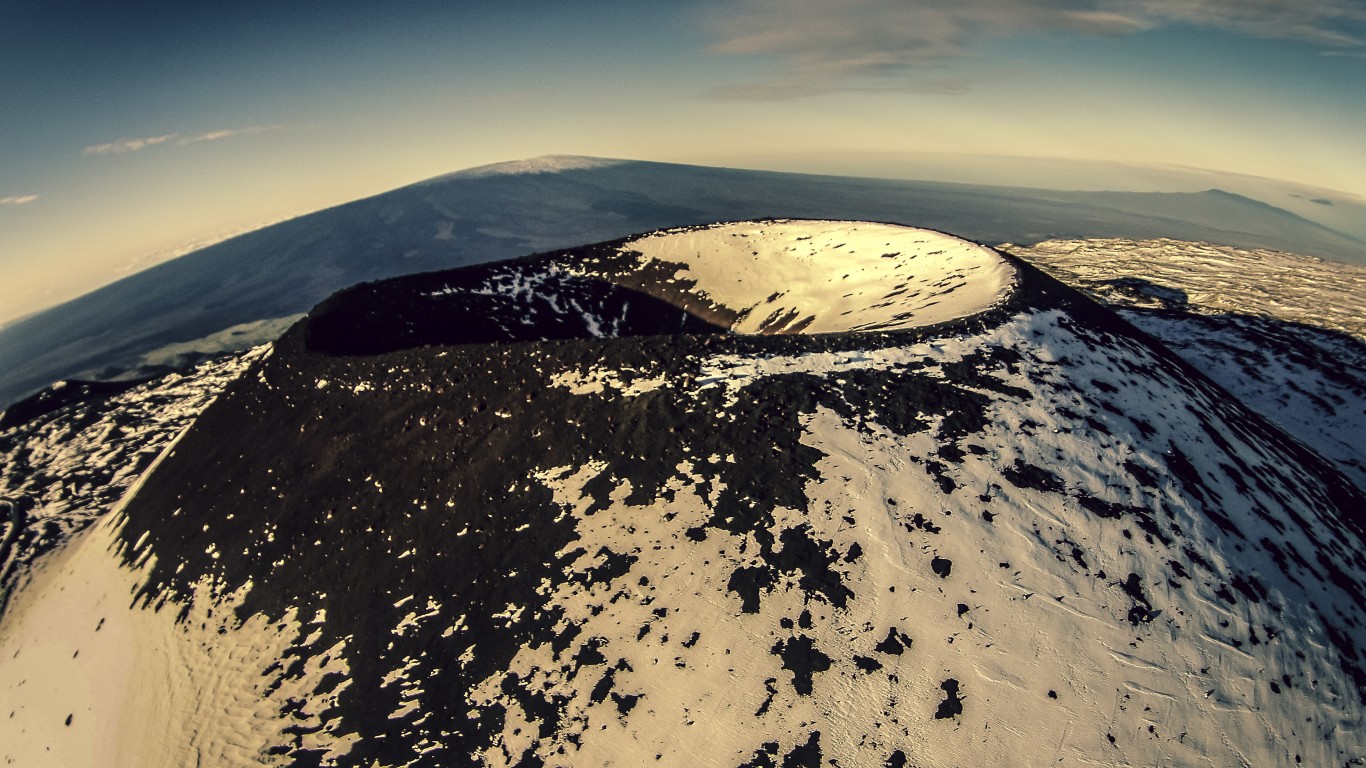
11. Hawaii
> Highest peak: Mauna Kea
> Elevation above sea level: 13,796 ft.
> Coordinates: 19.8° N, 155.5° W
> Value added from outdoor recreational activities: $3.16 billion
> Population: 1,415,872
Mauna Kea is 13,796 feet above sea level, but most of the mountain is under water. From base to tip, Mauna Kea is actually 33,500 feet tall — more than 4,000 feet taller than Mount Everest.
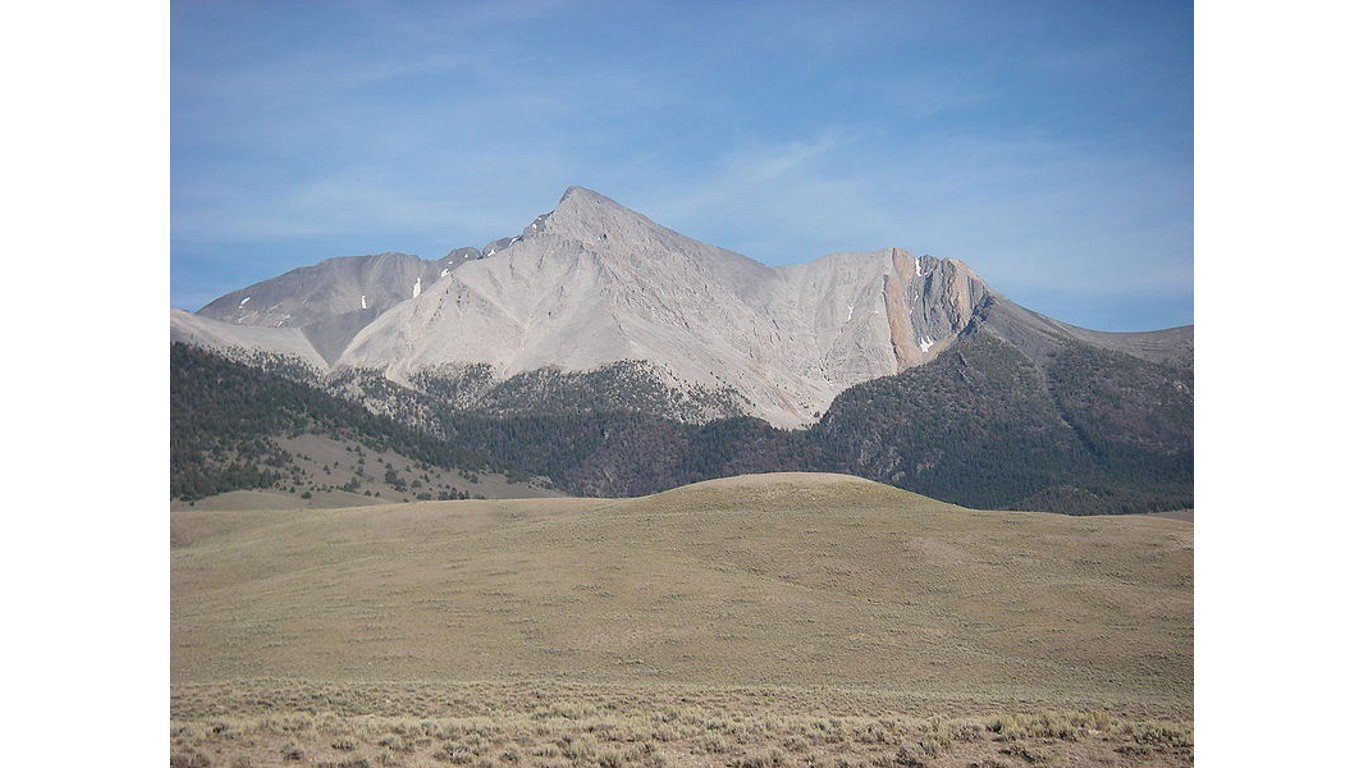
12. Idaho
> Highest peak: Borah Peak
> Elevation above sea level: 12,662 ft.
> Coordinates: 44.1° N, 113.8° W
> Value added from outdoor recreational activities: $2.24 billion
> Population: 1,787,065
Borah Peak can make for a difficult climb, particularly near the peak. The top of the mountain is so treacherous that it has gained the nickname “Chickenout Ridge.”
13. Illinois
> Highest peak: Charles Mound
> Elevation above sea level: 1,235 ft.
> Coordinates: 42.5° N, 90.2° W
> Value added from outdoor recreational activities: $13.66 billion
> Population: 12,671,821
Unlike most state high points, Charles Mound in Illinois actually sits on private property. The owners, however, are reportedly welcoming to people who hope to stand on Illinois’ highest point.
14. Indiana
> Highest peak: Hoosier Hill
> Elevation above sea level: 1,257 ft.
> Coordinates: 40.0° N, 84.9° W
> Value added from outdoor recreational activities: $9.85 billion
> Population: 6,732,219
Indiana’s highest point, Hoosier Hill, is a nondescript area in the woods of Wayne County. Perhaps the hill’s biggest claim to fame is that it was the last place Arthur H. Marshall visited in his quest to visit the highest point in the lower 48 states. Marshall is believed to be the first person to visit all 48 sites, making him the first known “highpointer”.
15. Iowa
> Highest peak: Hawkeye Point
> Elevation above sea level: 1,670 ft.
> Coordinates: 43.5° N, 95.7° W
> Value added from outdoor recreational activities: $3.57 billion
> Population: 3,155,070
Hawkeye Point only rises slightly above the surrounding farmland in Osceola, Iowa. The point sits on private land, but the owners have created a marker and make it accessible to the public.
16. Kansas
> Highest peak: Mount Sunflower
> Elevation above sea level: 4,039 ft.
> Coordinates: 39.0° N, 102.0° W
> Value added from outdoor recreational activities: $3.03 billion
> Population: 2,913,314
The state of Kansas is scientifically flatter than a pancake, so its highest point is barely distinguishable from the rest of the state. The name Mount Sunflower is tongue in cheek. The owners of the land, apparently in on the joke, put a plaque at Kansas’ highest point reading “Nothing happened here in 1897.”
17. Kentucky
> Highest peak: Black Mountain
> Elevation above sea level: 4,145 ft.
> Coordinates: 36.9° N, 82.9° W
> Value added from outdoor recreational activities: $4.05 billion
> Population: 4,467,673
Black Mountain has been a huge source of coal in Kentucky for decades. The mining has left the mountain in such precarious shape that would-be climbers must sign a waiver before summiting.
18. Louisiana
> Highest peak: Driskill Mountain
> Elevation above sea level: 535 ft.
> Coordinates: 32.4° N, 92.9° W
> Value added from outdoor recreational activities: $5.51 billion
> Population: 4,648,794
Louisiana sits partially below sea level and its highest point doesn’t rise too much higher than that. Driskill Mountain, located in the northern part of the state, is just 535 feet above sea level.
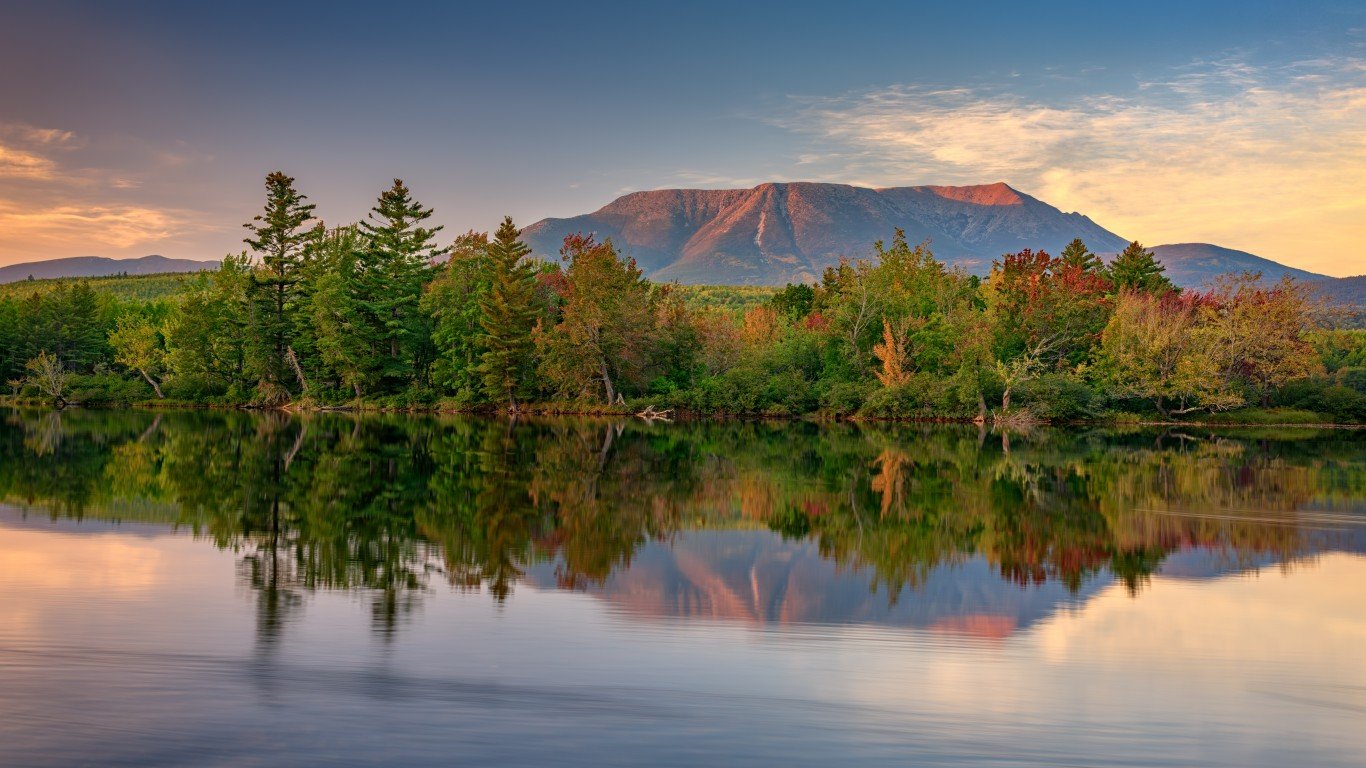
19. Maine
> Highest peak: Mount Katahdin
> Elevation above sea level: 5,268 ft.
> Coordinates: 45.9° N, 68.9° W
> Value added from outdoor recreational activities: $2.27 billion
> Population: 1,344,212
Mount Katahdin derives its name from the Penobscot tribe. In the Penobscot language, “Katahdin” roughly translates to “greatest mountain.” The mountain is the northernmost point on the Appalachian Trail.
20. Maryland
> Highest peak: Hoye Crest
> Elevation above sea level: 3,360 ft.
> Coordinates: 39.2° N, 79.5° W
> Value added from outdoor recreational activities: $5.51 billion
> Population: 6,045,680
Backbone Mountain, along with other parts of the Allegheny Mountains, make up part of the Eastern Continental Divide. The mountains help to naturally sort the water into the Chesapeake Bay before the water finally flows into the Gulf of Mexico.
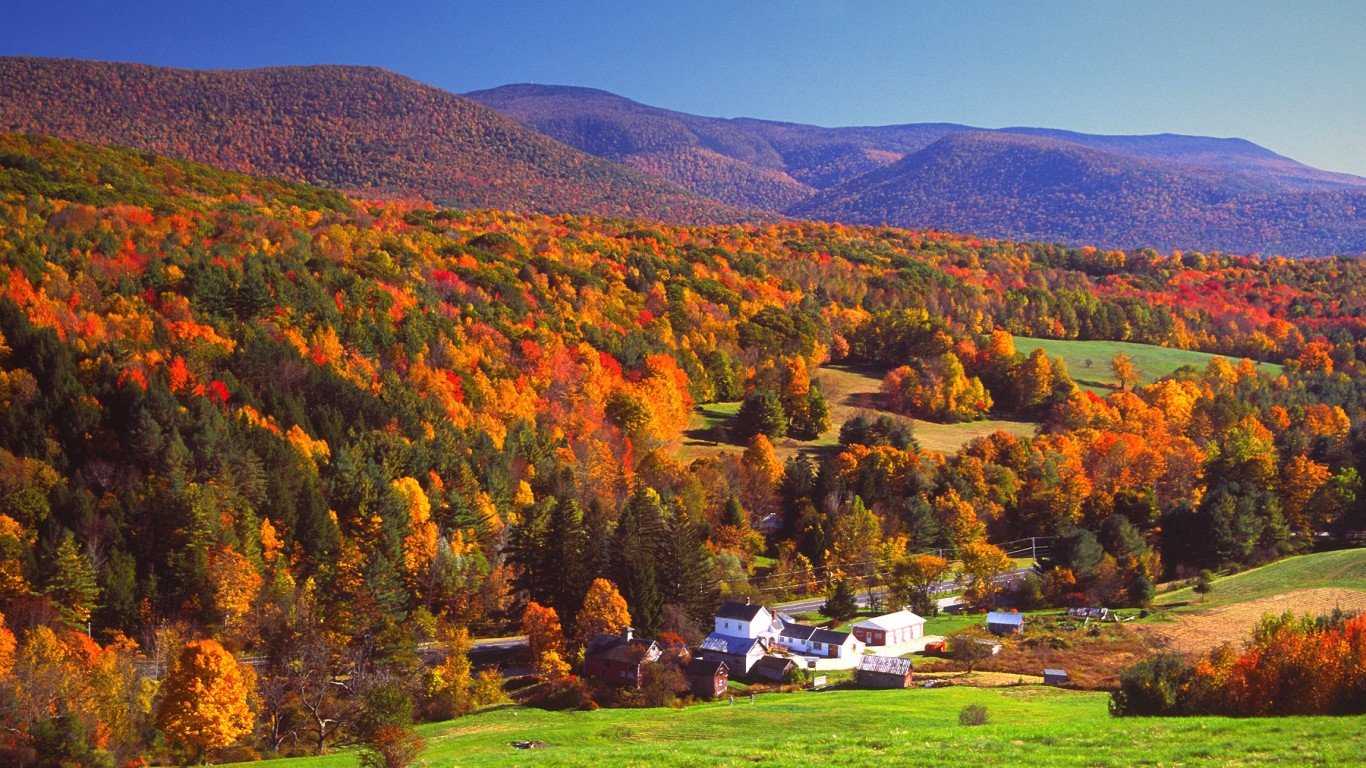
21. Massachusetts
> Highest peak: Mount Greylock
> Elevation above sea level: 3,491 ft.
> Coordinates: 42.6° N, 73.2° W
> Value added from outdoor recreational activities: $7.69 billion
> Population: 6,892,503
Mount Greylock has a unique place in literary history. It has reportedly inspired writers like Herman Melville and Oliver Wendell Holmes, who was also a jurist. The mountain even serves as the school for American witches and wizards in J.K. Rowling’s original “Fantastic Beasts and Where to Find Them.”
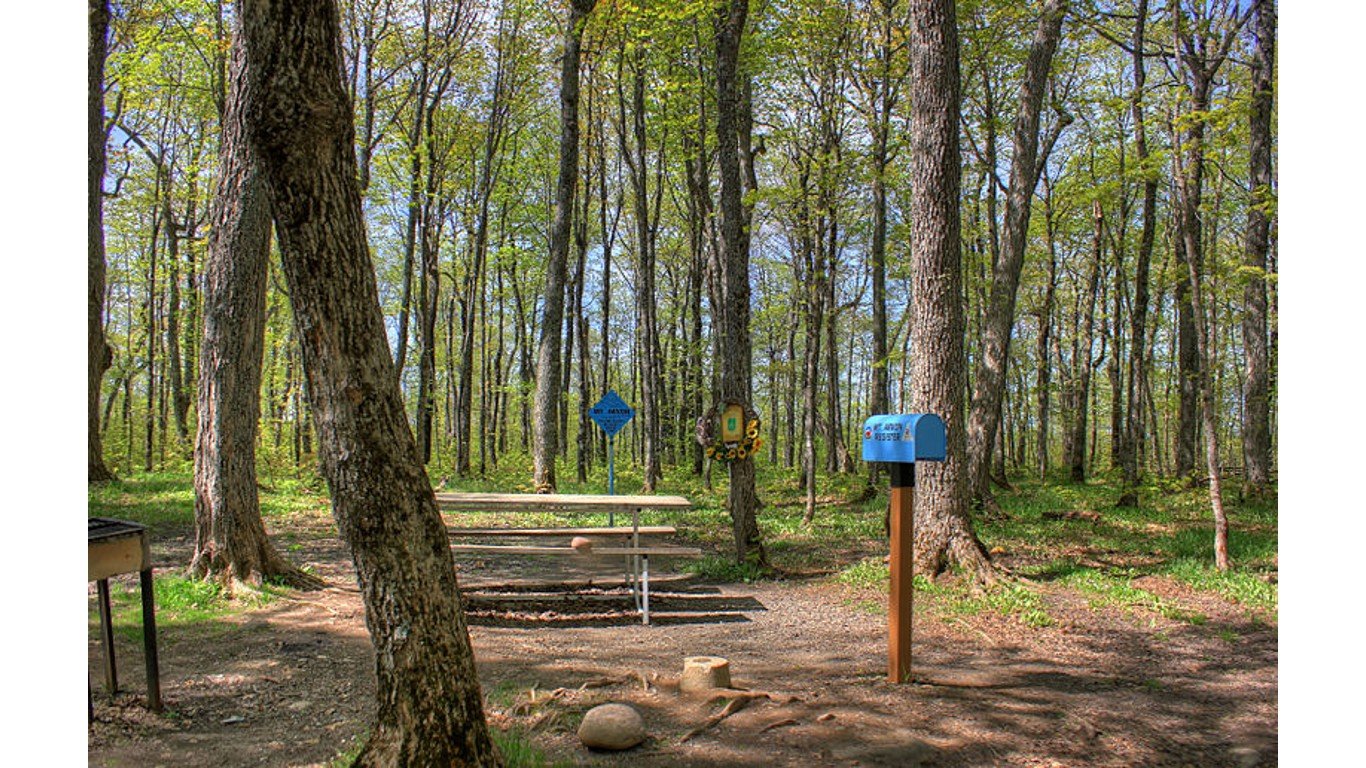
22. Michigan
> Highest peak: Mount Arvon
> Elevation above sea level: 1,979 ft.
> Coordinates: 46.8° N, 88.2° W
> Value added from outdoor recreational activities: $9.52 billion
> Population: 9,986,857
Mount Arvon only recently claimed the title as the highest place in Michigan. For years, Mount Curwood was believed to be Michigan’s highest point, but a 1982 survey revealed that Arvon edged out Curwood by just under 1 foot.
23. Minnesota
> Highest peak: Eagle Mountain
> Elevation above sea level: 2,301 ft.
> Coordinates: 47.9° N, 90.6° W
> Value added from outdoor recreational activities: $8.41 billion
> Population: 5,639,632
If you’re going to try to summit Eagle Mountain in Minnesota, be sure to double check your map before you go. There is another Eagle Mountain in Lutsen, Minnesota that is much shorter.
24. Mississippi
> Highest peak: Woodall Mountain
> Elevation above sea level: 806 ft.
> Coordinates: 34.8° N, 88.2° W
> Value added from outdoor recreational activities: $2.64 billion
> Population: 2,976,149
During the Civil War, Woodall Mountain provided Union forces with a huge tactical advantage. Soldiers used the mountain, then called Yow Hill, in the Battle of Iuka to rain down artillery on Confederate soldiers and drive them out of town.
25. Missouri
> Highest peak: Taum Sauk Mountain
> Elevation above sea level: 1,772 ft.
> Coordinates: 37.6° N, 90.7° W
> Value added from outdoor recreational activities: $6.45 billion
> Population: 6,137,428
Taum Sauk Mountain State Park crosses paths with the Ozark Trail. It also features Mina Sauk Falls, which is the largest waterfall in Missouri as well.
26. Montana
> Highest peak: Granite Peak
> Elevation above sea level: 12,799 ft.
> Coordinates: 45.2° N, 109.8° W
> Value added from outdoor recreational activities: $2.24 billion
> Population: 1,068,778
Granite Peak is one of the most dangerous state high points to get to because of its strenuous hiking trails and challenging rock climbing. It’s believed that no one made it to the summit until 1923.
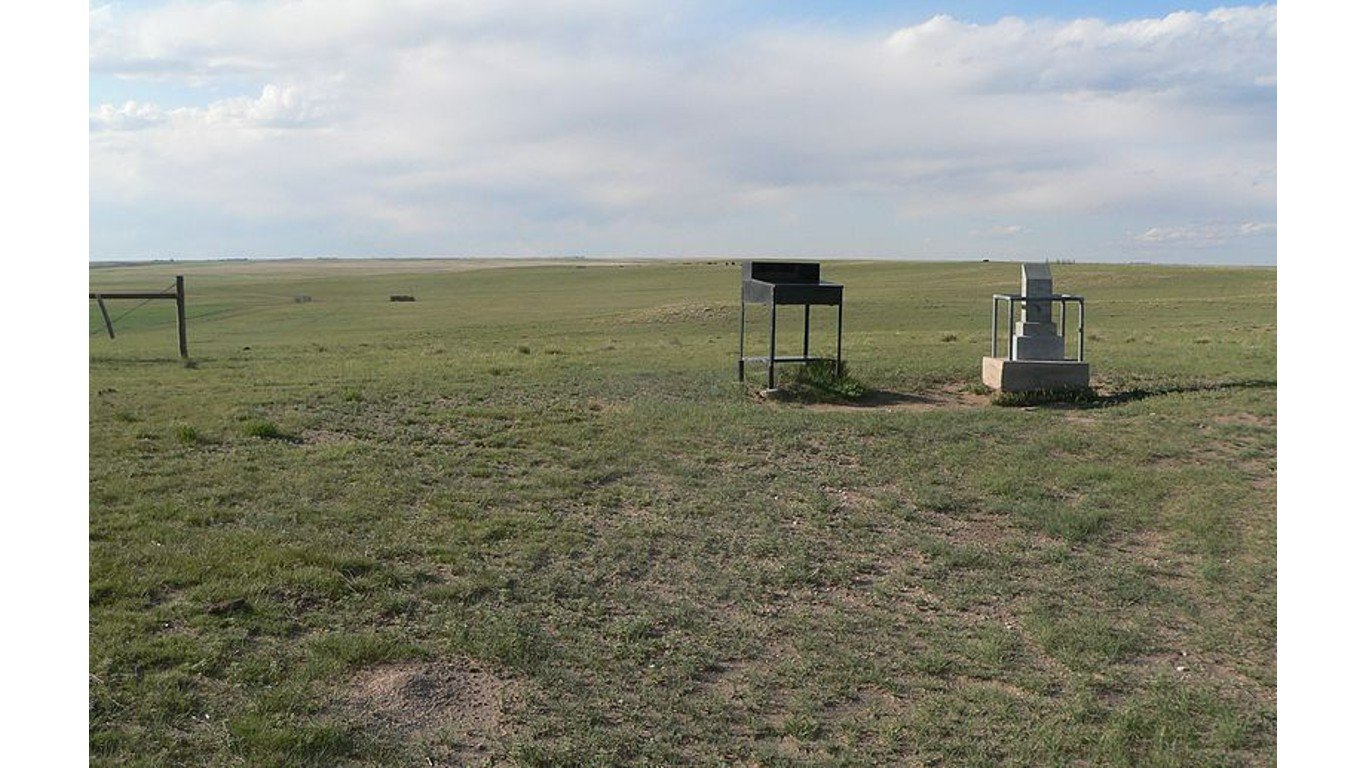
27. Nebraska
> Highest peak: Panorama Point
> Elevation above sea level: 5,424 ft.
> Coordinates: 41.0° N, 104.0° W
> Value added from outdoor recreational activities: $2.18 billion
> Population: 1,934,408
Panorama Point is just slightly higher than its surrounding areas and may be tough to tell apart were it not for a marker placed there. Still, Panorama Point provides an excellent view of the Nebraska plains.
28. Nevada
> Highest peak: Boundary Peak
> Elevation above sea level: 13,140 ft.
> Coordinates: 37.8° N, 118.4° W
> Value added from outdoor recreational activities: $3.98 billion
> Population: 3,080,156
Boundary Peak is appropriately named because of its proximity to California. Boundary Peak is about 200 feet shorter than its twin, Montgomery Peak, but Montgomery sits within California’s state borders.
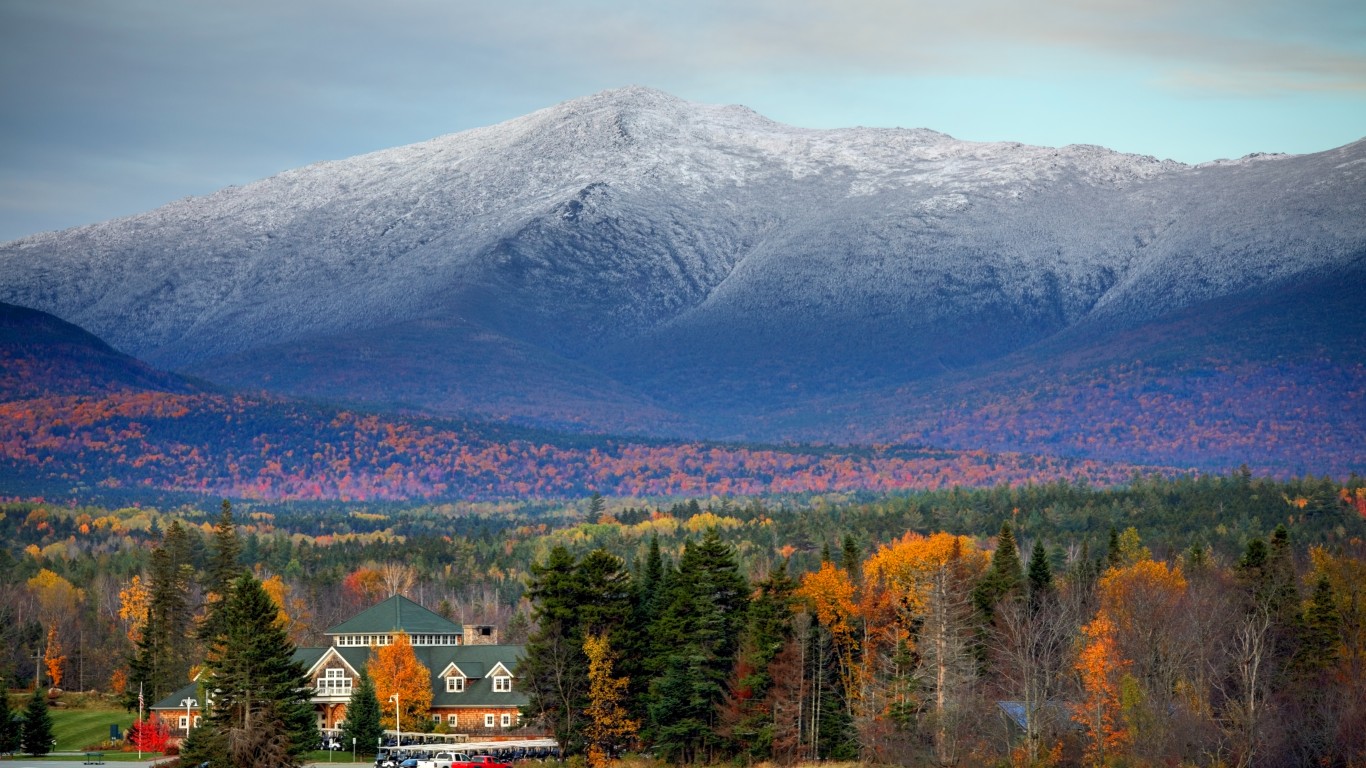
29. New Hampshire
> Highest peak: Mount Washington
> Elevation above sea level: 6,288 ft.
> Coordinates: 44.3° N, 71.3° W
> Value added from outdoor recreational activities: $2.26 billion
> Population: 1,359,711
Mount Washington is known more for its volatile weather than its height. The mountain is home to an observatory that recorded temperatures of -100 degrees with windchill in early January. The fastest gust of wind ever, at 231 miles per hour, also was recorded there in 1934. The record stood until 1996, when it was replaced by a typhoon in Australia.
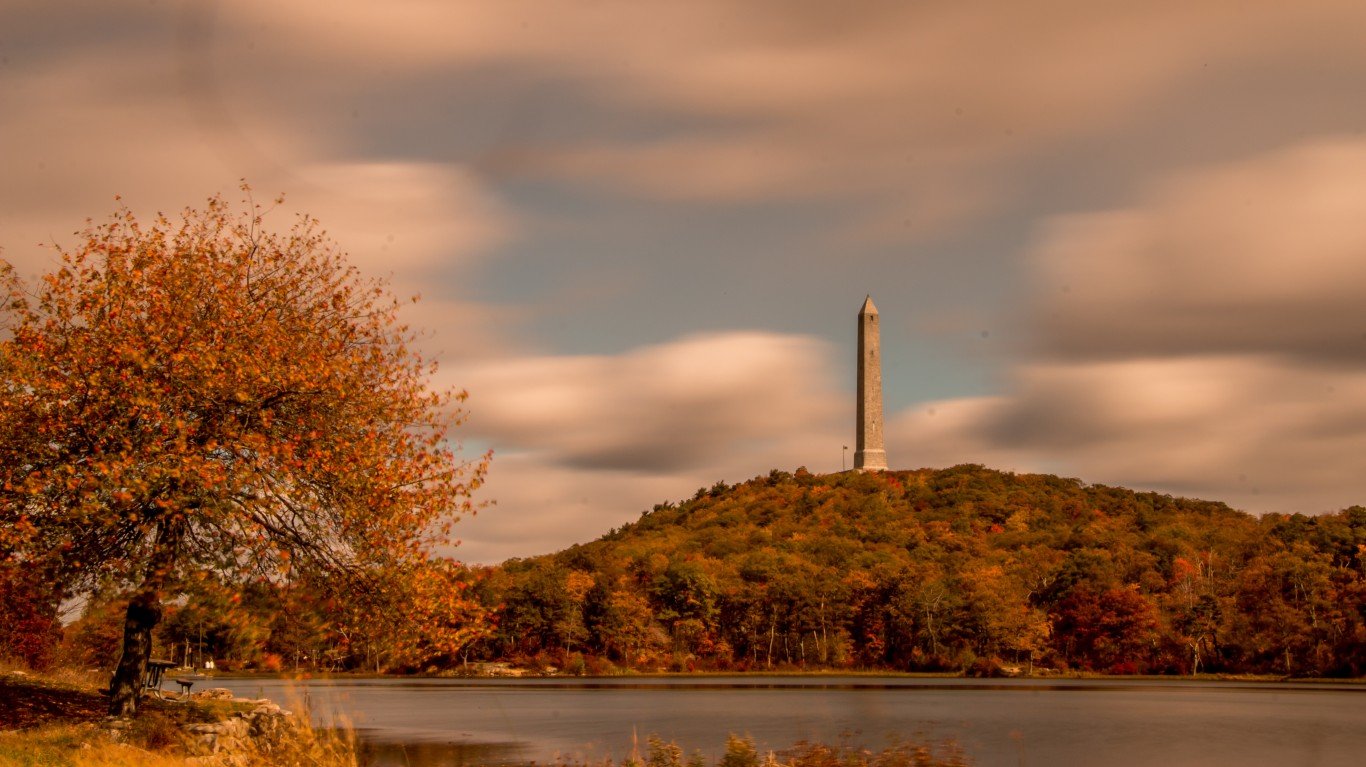
30. New Jersey
> Highest peak: High Point
> Elevation above sea level: 1,803 ft.
> Coordinates: 41.3° N, 74.7° W
> Value added from outdoor recreational activities: $8.71 billion
> Population: 8,882,190
The appropriately named High Point peaks out above the rest of the Kittatinny Mountains in New Jersey. As if it’s not tall enough, an obelisk at the peak adds another 220 feet to the top of High Point. It was placed there in 1930 as a war veteran memorial.

31. New Mexico
> Highest peak: Wheeler Peak
> Elevation above sea level: 13,161 ft.
> Coordinates: 36.6° N, 105.4° W
> Value added from outdoor recreational activities: $1.89 billion
> Population: 2,096,829
For much of its history, Wheeler Peak was named Taos Peak. The name was changed in 1950 in honor of George Montague Wheeler, who led the effort to survey New Mexico and other areas in the Southwest.
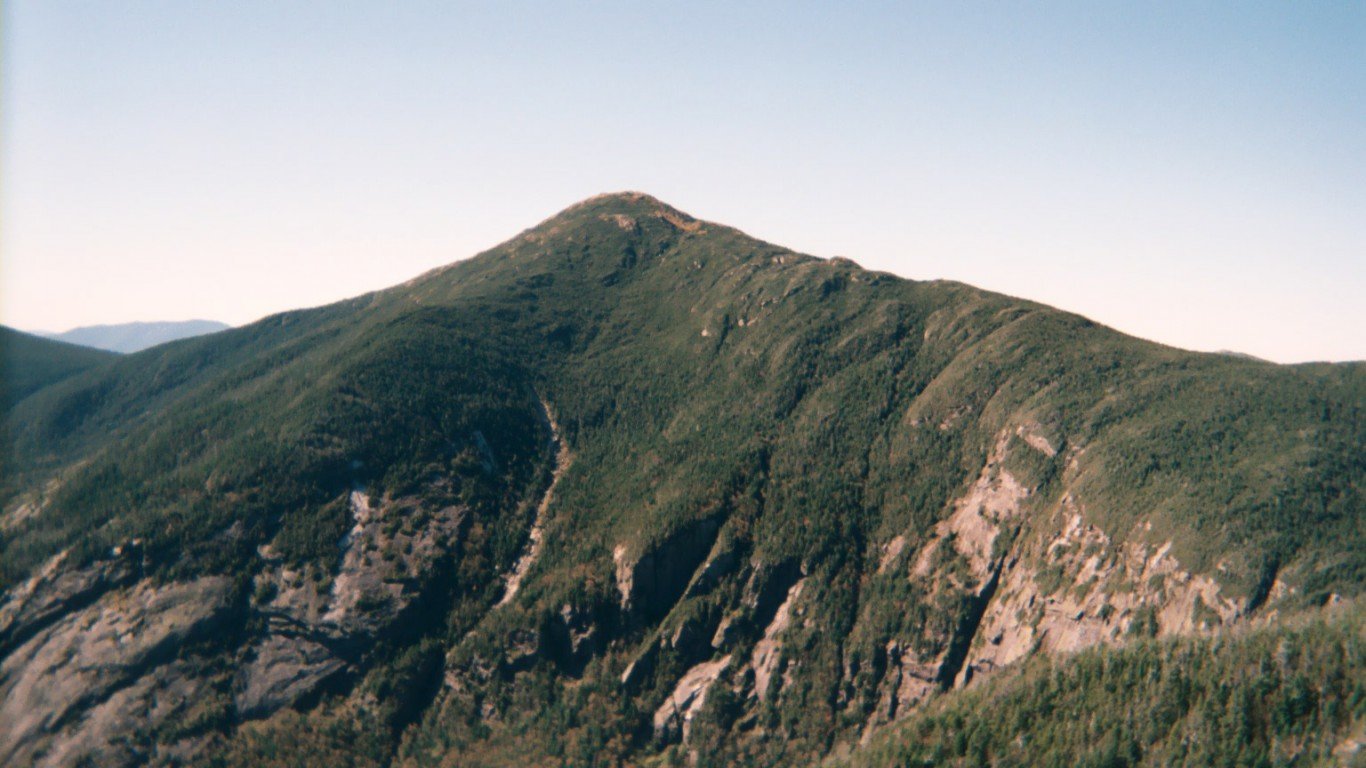
32. New York
> Highest peak: Mount Marcy
> Elevation above sea level: 5,344 ft.
> Coordinates: 44.1° N, 73.9° W
> Value added from outdoor recreational activities: $21.09 billion
> Population: 19,453,561
New York is known for its tall buildings, but its tallest natural peak reaches just over 1 mile above sea level. Mount Marcy sits in the Adirondack Mountains in upstate New York. As far as mountains go, Marcy is fairly isolated, providing spectacular views of the surrounding area.
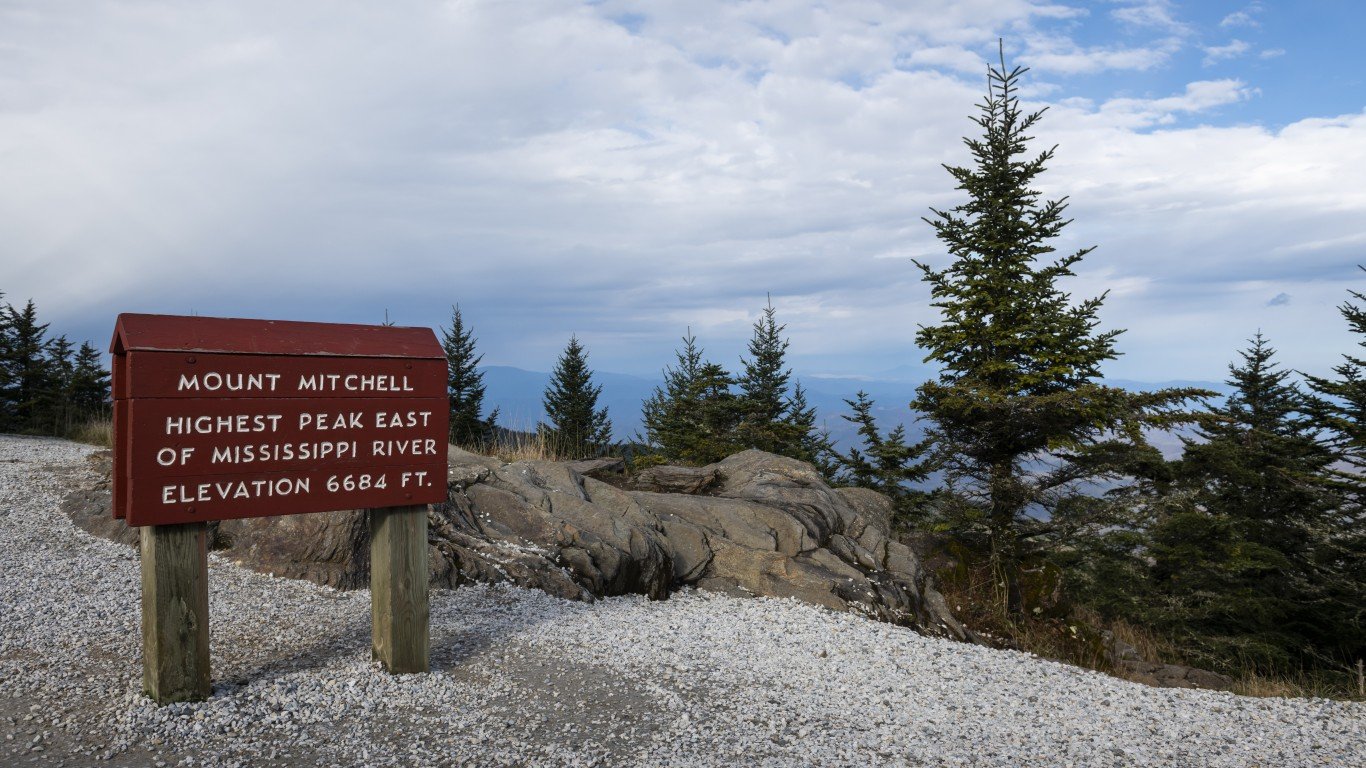
33. North Carolina
> Highest peak: Mount Mitchell
> Elevation above sea level: 6,684 ft.
> Coordinates: 35.8° N, 82.3° W
> Value added from outdoor recreational activities: $9.96 billion
> Population: 10,488,084
Mount Mitchell is named for Elisha Mitchell, the professor who determined that the mountain was in fact the tallest in the eastern U.S. Tragically, Mitchell died after his findings were challenged. When he went back to prove his claim, he fell to his death at a nearby waterfall.
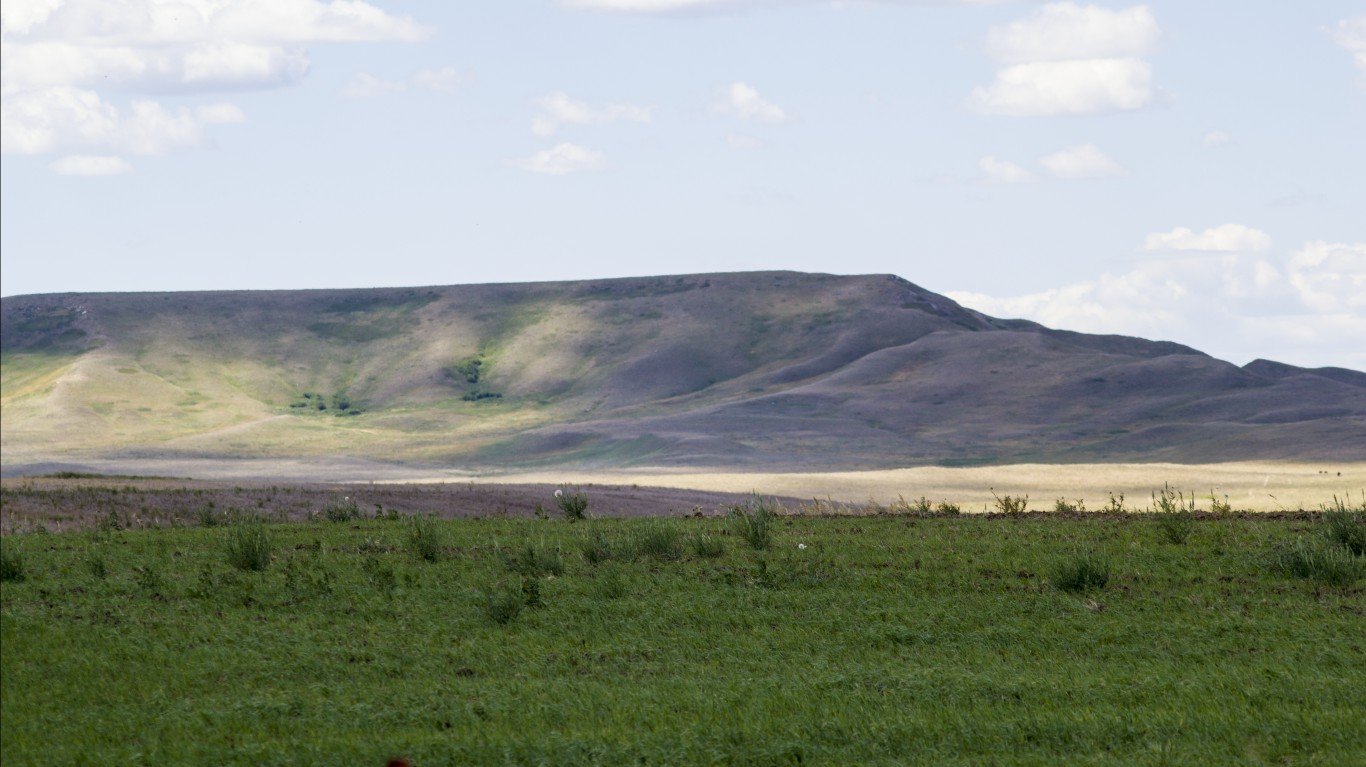
34. North Dakota
> Highest peak: White Butte
> Elevation above sea level: 3,506 ft.
> Coordinates: 46.4° N, 103.3° W
> Value added from outdoor recreational activities: $1.18 billion
> Population: 762,062
White Butte resides in the Little Missouri National Grasslands, but it is noticeable because of its chalky white color. The source of the color is from the bentonite clay that makes up the butte, which was formed by a glacier that covered the area thousands of years earlier.
35. Ohio
> Highest peak: Campbell Hill
> Elevation above sea level: 1,550 ft.
> Coordinates: 40.4° N, 83.7° W
> Value added from outdoor recreational activities: $10.65 billion
> Population: 11,689,100
Campbell Hill in Ohio is just the high point of a gentle slope near some farmland. The hill was once home to an Air Force base, but that has since moved. A vocational school now sits in its place.
36. Oklahoma
> Highest peak: Black Mesa
> Elevation above sea level: 4,973 ft.
> Coordinates: 36.9° N, 103.0° W
> Value added from outdoor recreational activities: $3.64 billion
> Population: 3,956,971
Oklahoma’s Black Mesa was once outside the jurisdiction of law enforcement, making it an ideal place for outlaws such as Black Jack Ketchum and William Coe to avoid authorities. More recently, some Oklahomans have claimed they were abducted by aliens near the Black Mesa area.
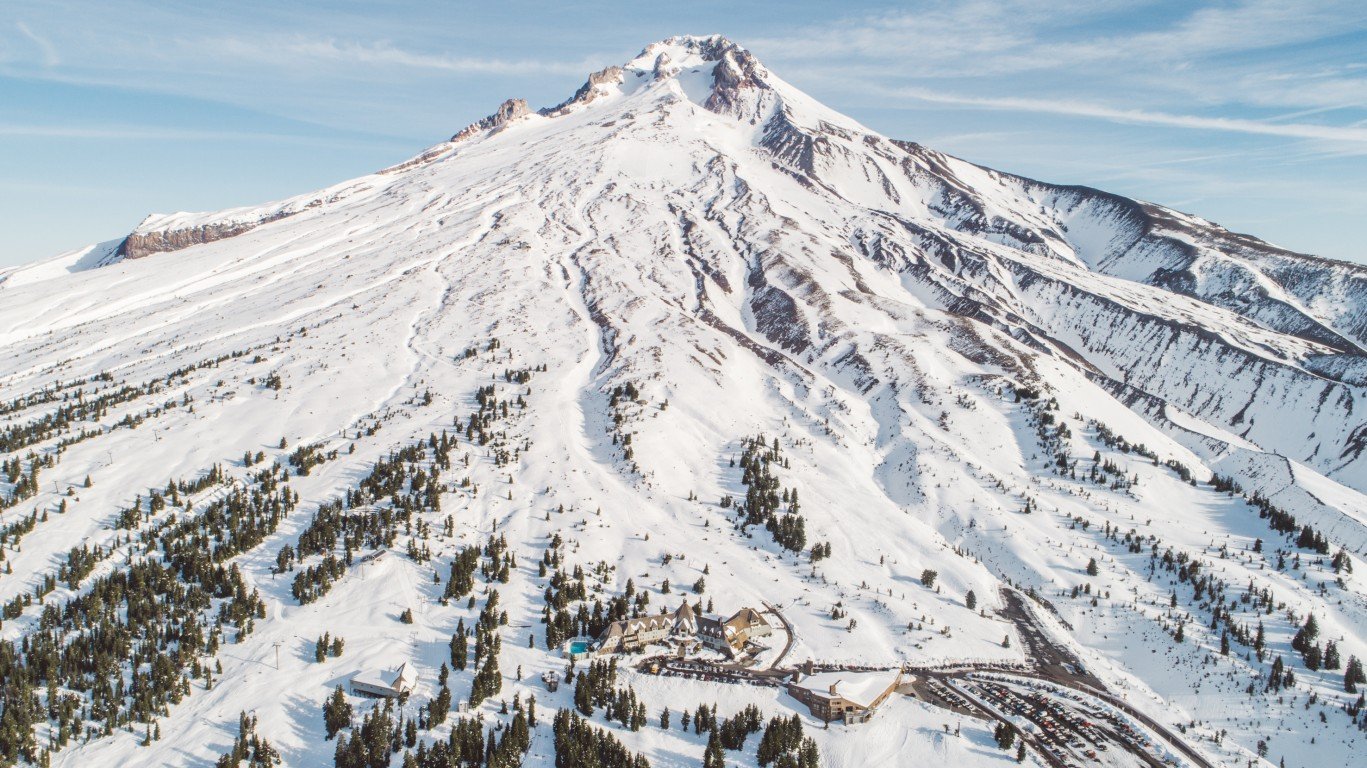
37. Oregon
> Highest peak: Mount Hood
> Elevation above sea level: 11,239 ft.
> Coordinates: 45.4° N, 121.7° W
> Value added from outdoor recreational activities: $5.28 billion
> Population: 4,217,737
The volcano Mount Hood hasn’t erupted in well over a century, and the U.S. Geological Survey believes the chances of an imminent eruption are very slim. The peak of Mount Hood is covered with 11 different glaciers.
38. Pennsylvania
> Highest peak: Mount Davis
> Elevation above sea level: 3,213 ft.
> Coordinates: 39.8° N, 79.2° W
> Value added from outdoor recreational activities: $11.81 billion
> Population: 12,801,989
Though Mount Davis towers over the rest of Pennsylvania, the peak is relatively flat. This means it can be hard to see much of the surrounding area like the base of the mountain.
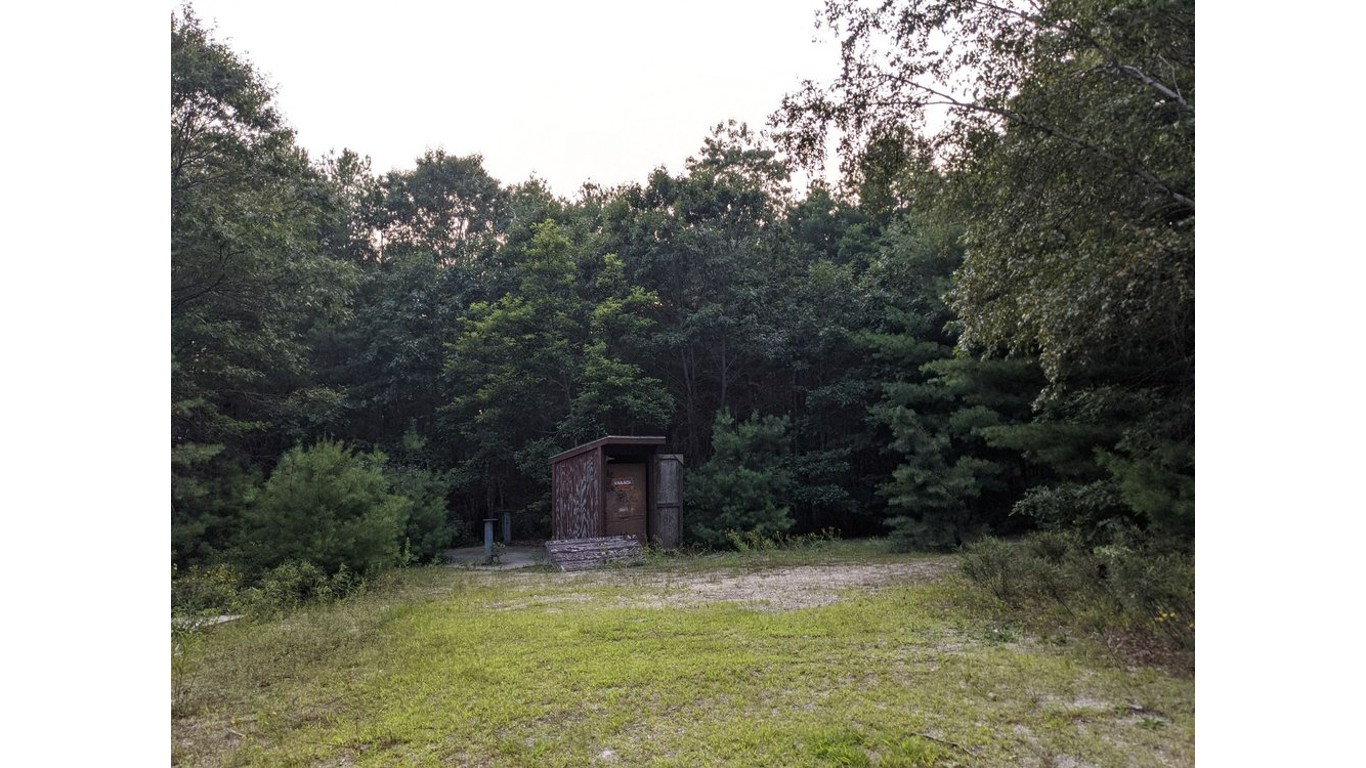
39. Rhode Island
> Highest peak: Jerimoth Hill
> Elevation above sea level: 812 ft.
> Coordinates: 41.9° N, 71.8° W
> Value added from outdoor recreational activities: $1.13 billion
> Population: 1,059,361
Despite its low elevation, Jerimoth Hill used to be one of the most difficult state high points to reach. The hike wasn’t difficult, but the man who owned the land was notoriously unfriendly to those wanting to summit the hill. Eventually, he relented and sold the land, which is now open to hikers.
40. South Carolina
> Highest peak: Sassafras Mountain
> Elevation above sea level: 3,560 ft.
> Coordinates: 35.1° N, 82.8° W
> Value added from outdoor recreational activities: $5.75 billion
> Population: 5,148,714
Sassafras Mountain is dwarfed by many nearby mountains in the Blue Ridge Mountain Range. It may have been largely unnoticed, except that it falls just on the South Carolina side of the border with North Carolina, making it the tallest in its state.
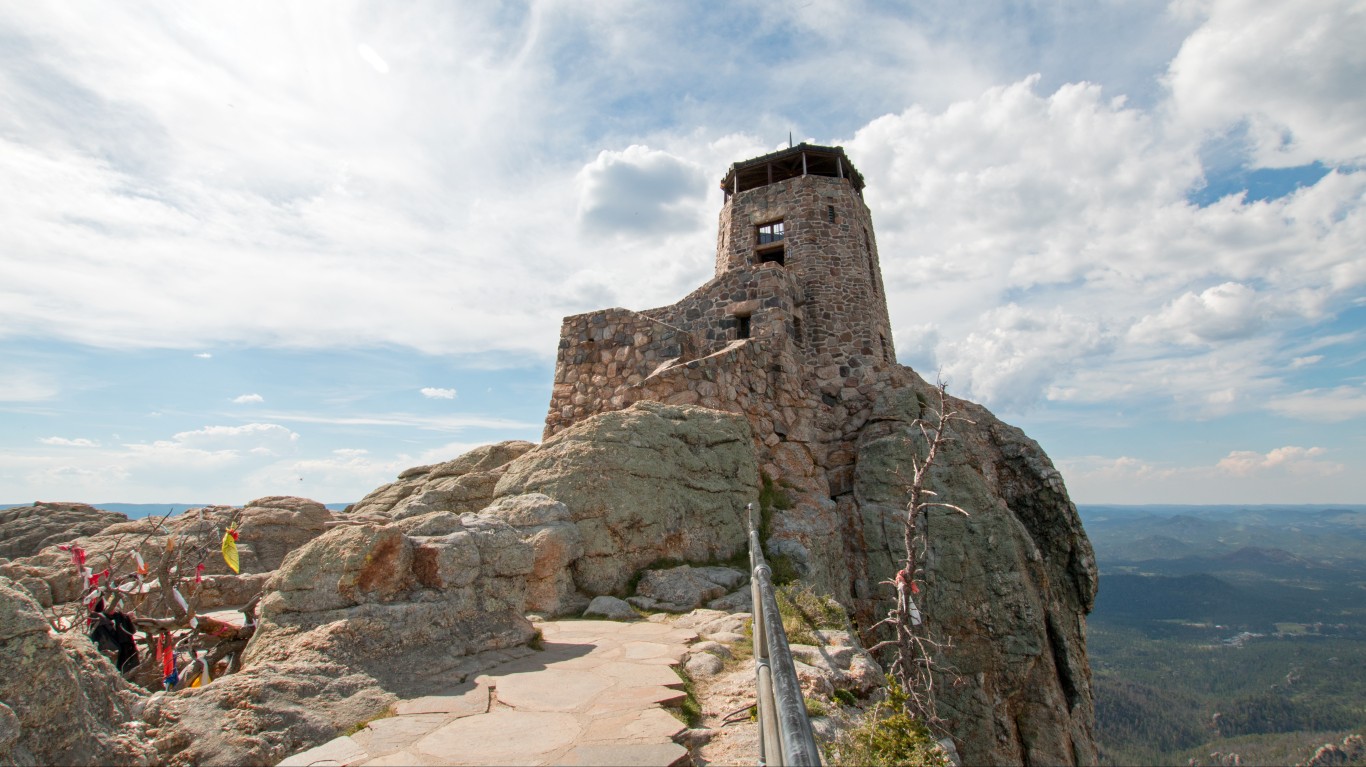
41. South Dakota
> Highest peak: Black Elk Peak
> Elevation above sea level: 7,242 ft.
> Coordinates: 43.9° N, 103.5° W
> Value added from outdoor recreational activities: $1.16 billion
> Population: 884,659
Until 2016, Black Elk Peak was named Harney Peak. There was a significant effort from Native American groups to change the name as Gen. William Harney gained notoriety for fighting Natives during the U.S. westward expansion, whereas Black Elk was a revered spiritual leader.
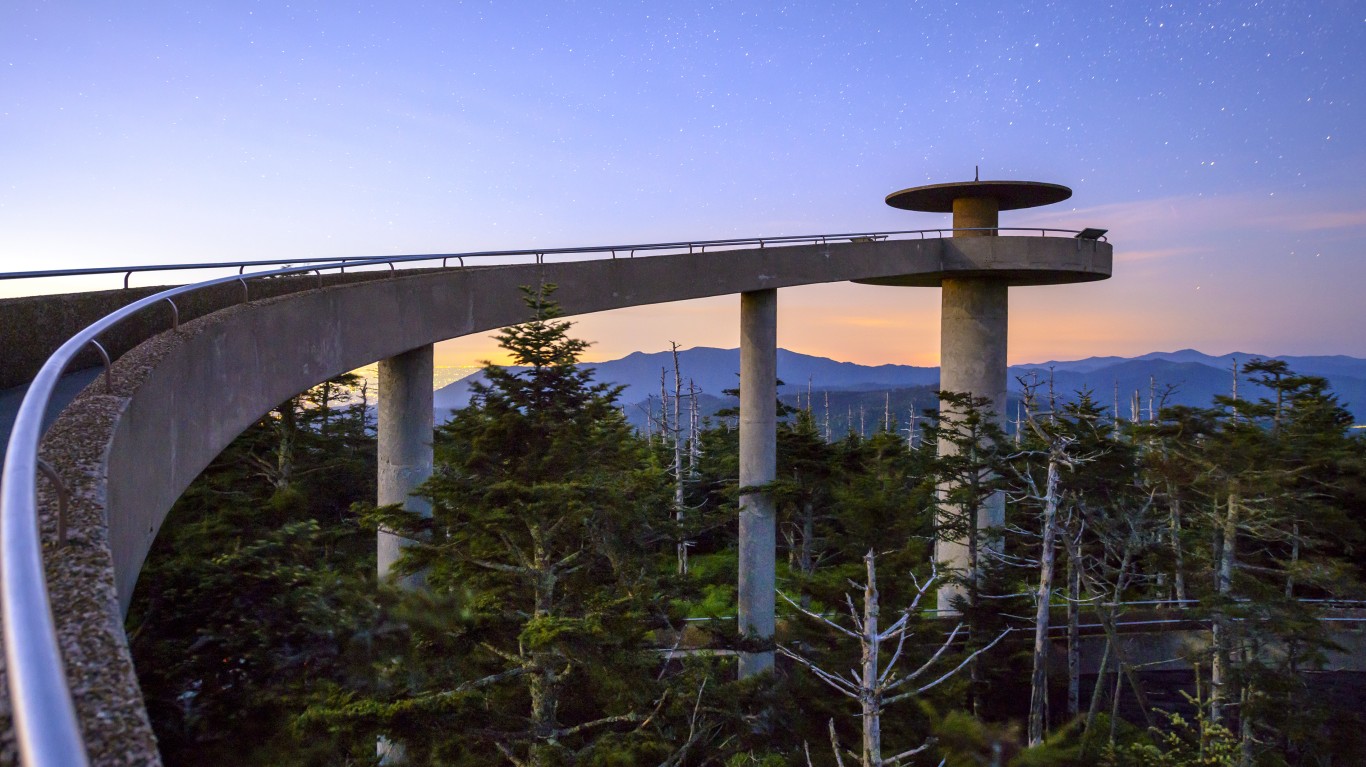
42. Tennessee
> Highest peak: Clingmans Dome
> Elevation above sea level: 6,643 ft.
> Coordinates: 35.6° N, 83.5° W
> Value added from outdoor recreational activities: $7.23 billion
> Population: 6,829,174
Clingmans Dome in the Great Smoky Mountains National Park is so tall that it is one of the few spots that can offer both hiking and skiing. The road up to the peak is closed from December through March to cars, but cross-country skiers can still get around.

43. Texas
> Highest peak: Guadalupe Peak
> Elevation above sea level: 8,749 ft.
> Coordinates: 31.9° N, 104.9° W
> Value added from outdoor recreational activities: $31.65 billion
> Population: 28,995,881
Guadalupe Peak is a challenge to hike, but those who can muster the six- to eight-hour round trip journey will be rewarded with an unparalleled view of the American Southwest. American Airlines placed a steel monument at the top of the peak in 1958 to honor stagecoach drivers who delivered mail to remote areas in the 1800s.
44. Utah
> Highest peak: Kings Peak
> Elevation above sea level: 13,528 ft.
> Coordinates: 40.8° N, 110.4° W
> Value added from outdoor recreational activities: $4.92 billion
> Population: 3,205,958
Despite its regal views, Kings Peak wasn’t named after a monarch. The name comes from Clarence King, the United States Geological Survey’s first director. Anyone hoping to summit Kings Peak should carve out at least two days for the trip as the standard hiking trip is nearly 30 miles round trip.
45. Vermont
> Highest peak: Mount Mansfield
> Elevation above sea level: 4,393 ft.
> Coordinates: 44.5° N, 72.8° W
> Value added from outdoor recreational activities: $1.25 billion
> Population: 623,989
Many tall mountain peaks could be described as beautiful, but Mount Mansfield may be the only one that might be considered handsome. When viewed from the east, the mountain resembles a man’s face in profile. Parts of the mountain have gained anatomical nicknames, including Adams Apple, Chin, Nose, and Forehead.
46. Virginia
> Highest peak: Mount Rogers
> Elevation above sea level: 5,729 ft.
> Coordinates: 36.7° N, 81.5° W
> Value added from outdoor recreational activities: $7.99 billion
> Population: 8,535,519
Mount Rogers is a popular tourist destination, offering numerous different outdoor activities. Visitors can hike, swim, ride horses, and even cross-country ski during the winter. The area has 500 miles of trails and welcomes over 1 billion visitors annually.
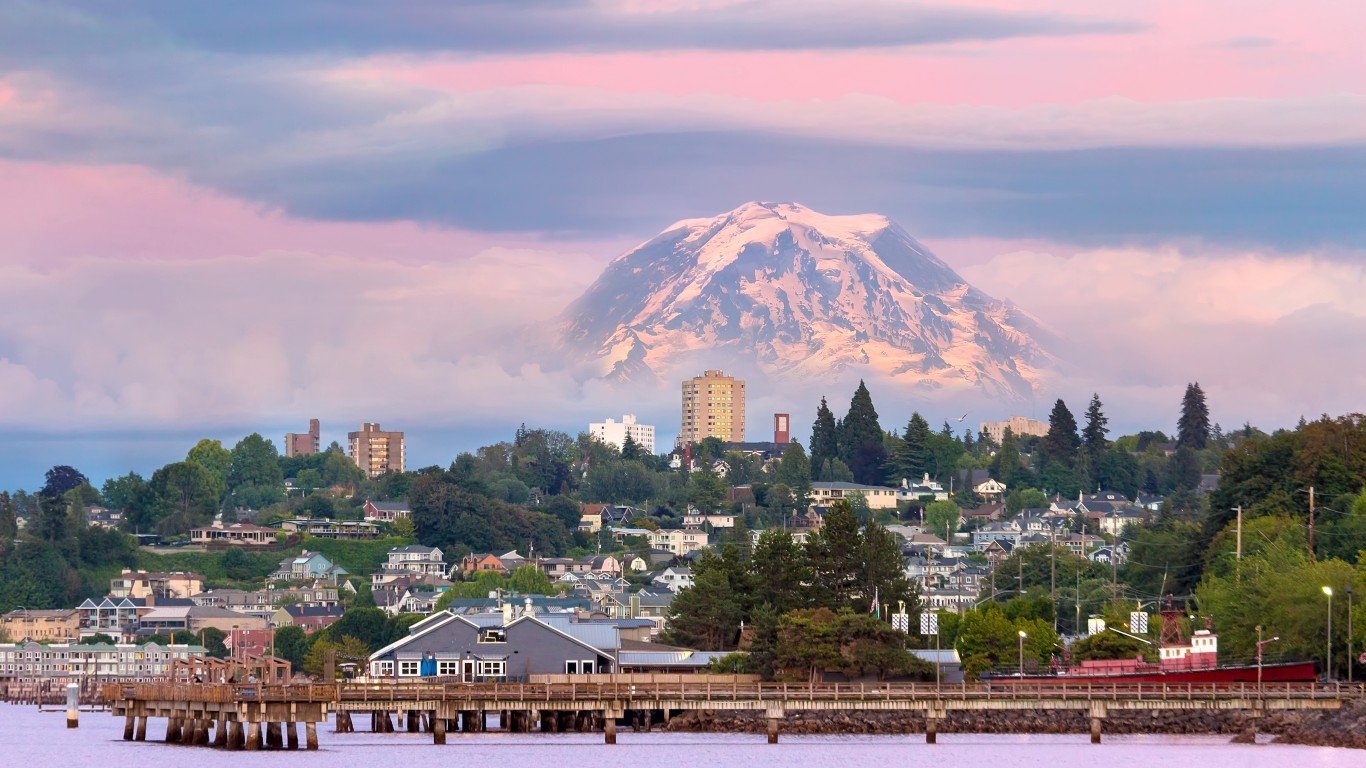
47. Washington
> Highest peak: Mount Rainier
> Elevation above sea level: 14,411 ft.
> Coordinates: 46.9° N, 121.8° W
> Value added from outdoor recreational activities: $10.27 billion
> Population: 7,614,893
Though it may be enticing to climbers and hikers in the Pacific Northwest, Mount Rainier should be viewed with some caution. The United States Geological Survey reports that Rainier is one of the most dangerous volcanoes in the country, and it may go off with little or no warning.
48. West Virginia
> Highest peak: Spruce Knob
> Elevation above sea level: 4,863 ft.
> Coordinates: 38.7° N, 79.5° W
> Value added from outdoor recreational activities: $1.4 billion
> Population: 1,792,147
Spruce Knob towers over the rest of West Virginia and the entire Allegheny Mountain range. There is an observation deck at the top of the mountain, offering a full view of the surrounding area.
49. Wisconsin
> Highest peak: Timms Hill
> Elevation above sea level: 1,951 ft.
> Coordinates: 45.5° N, 90.2° W
> Value added from outdoor recreational activities: $7.78 billion
> Population: 5,822,434
Timms Hill sits between Timms Lake and Bass Lake, making it an optimal fishing destination. During the colder months, the hill is still accessible by snowmobile and offers a place for cross-country skiing and snowshoeing.
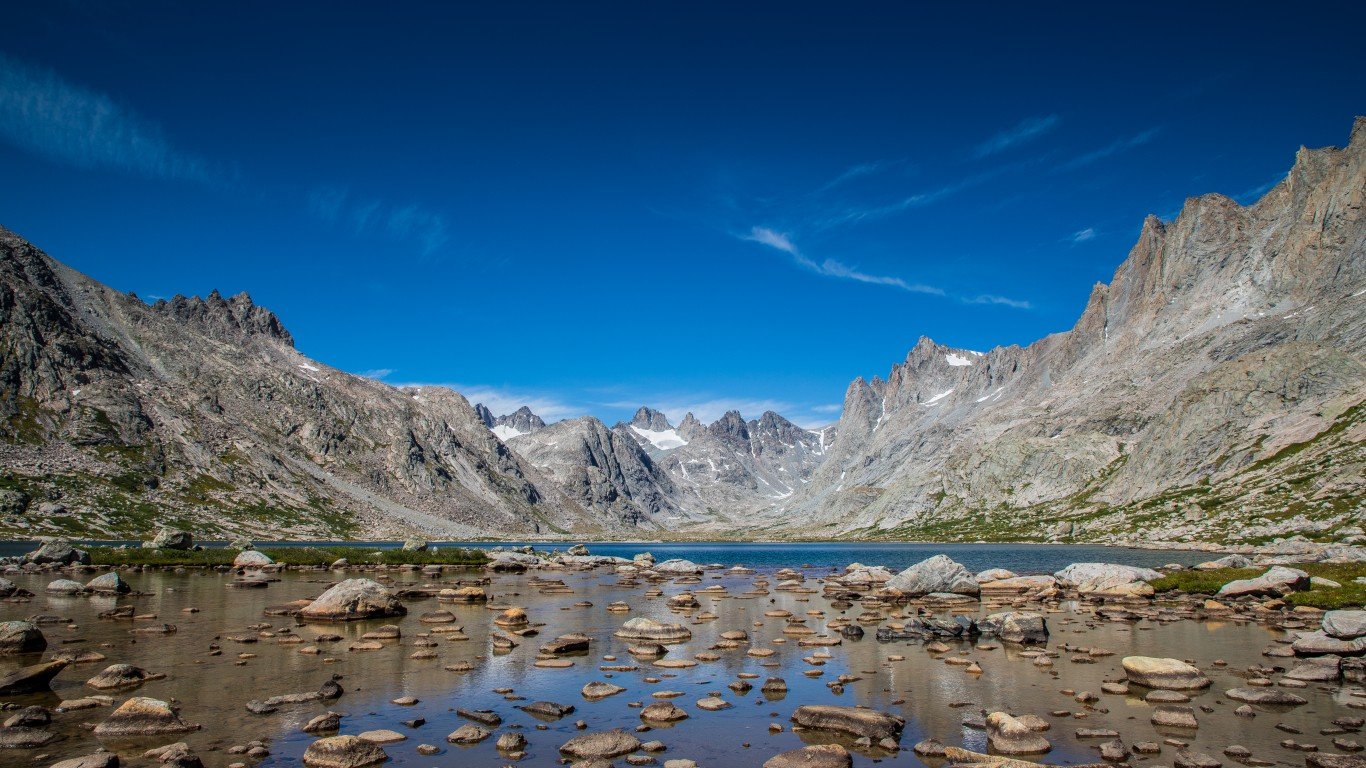
50. Wyoming
> Highest peak: Gannett Peak
> Elevation above sea level: 13,804 ft.
> Coordinates: 43.2° N, 109.7° W
> Value added from outdoor recreational activities: $1.25 billion
> Population: 578,759
Gannett Peak in Wyoming is reserved for only the most experienced mountaineers and climbers. The tallest of the Wind River mountain range is extremely remote and challenging to climb. Most people need several days to get to the top.
